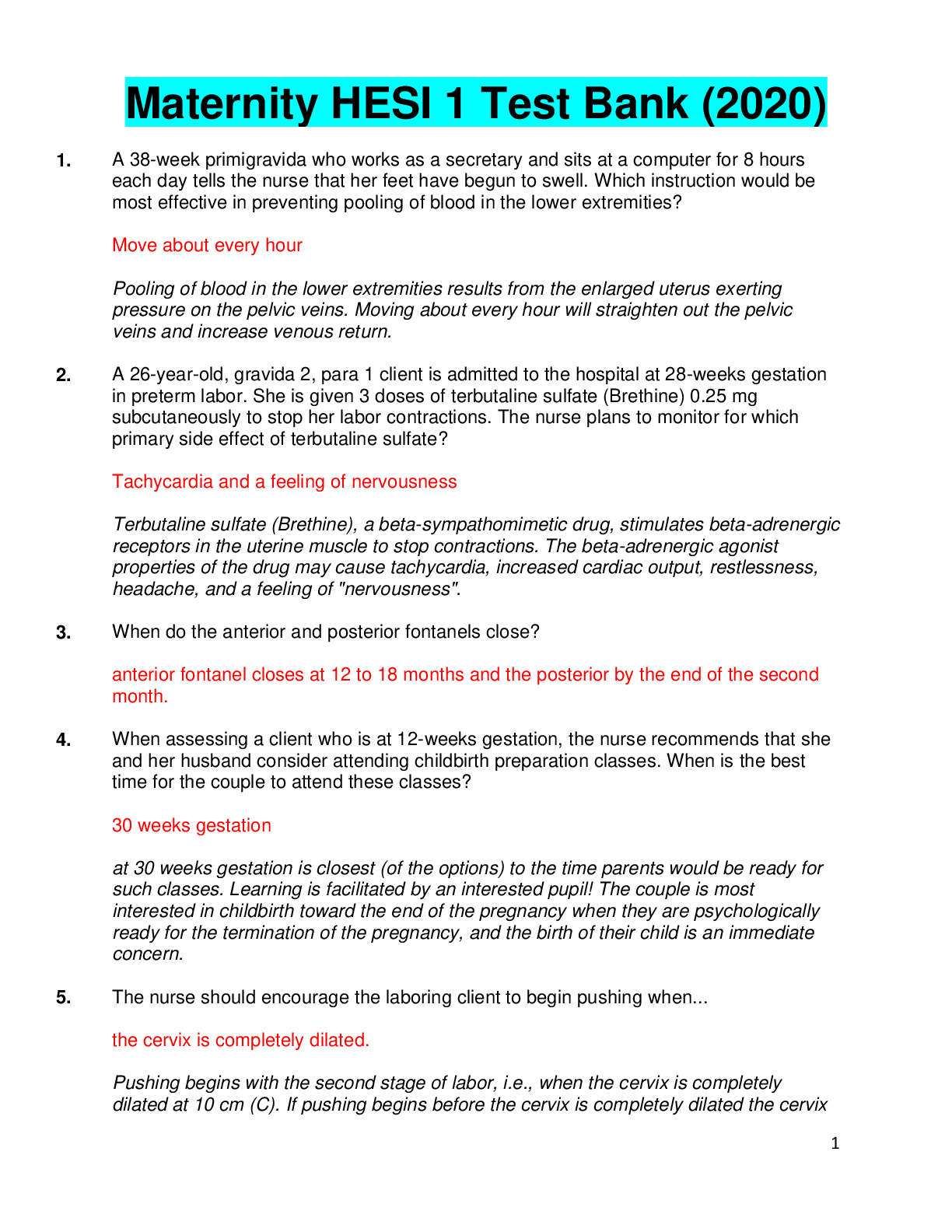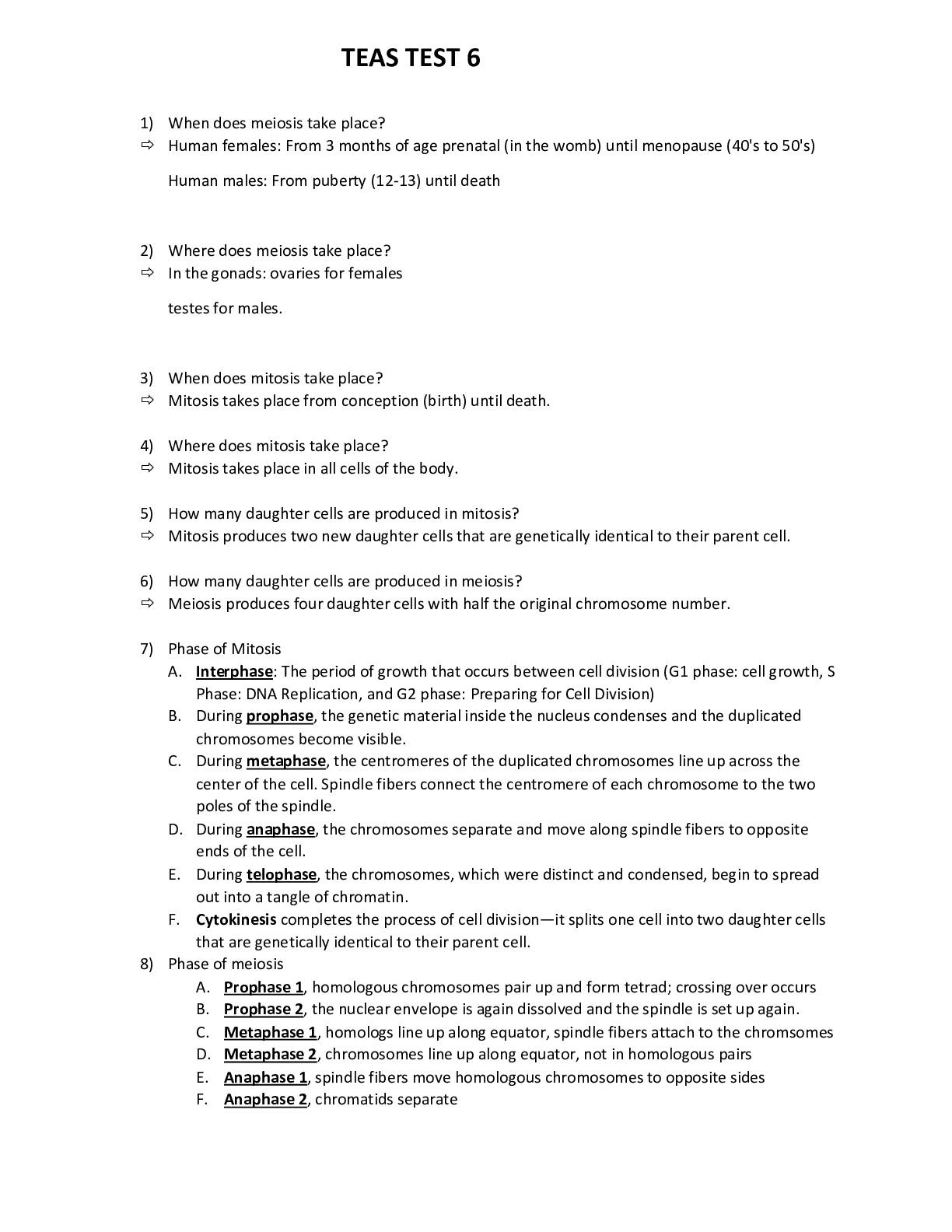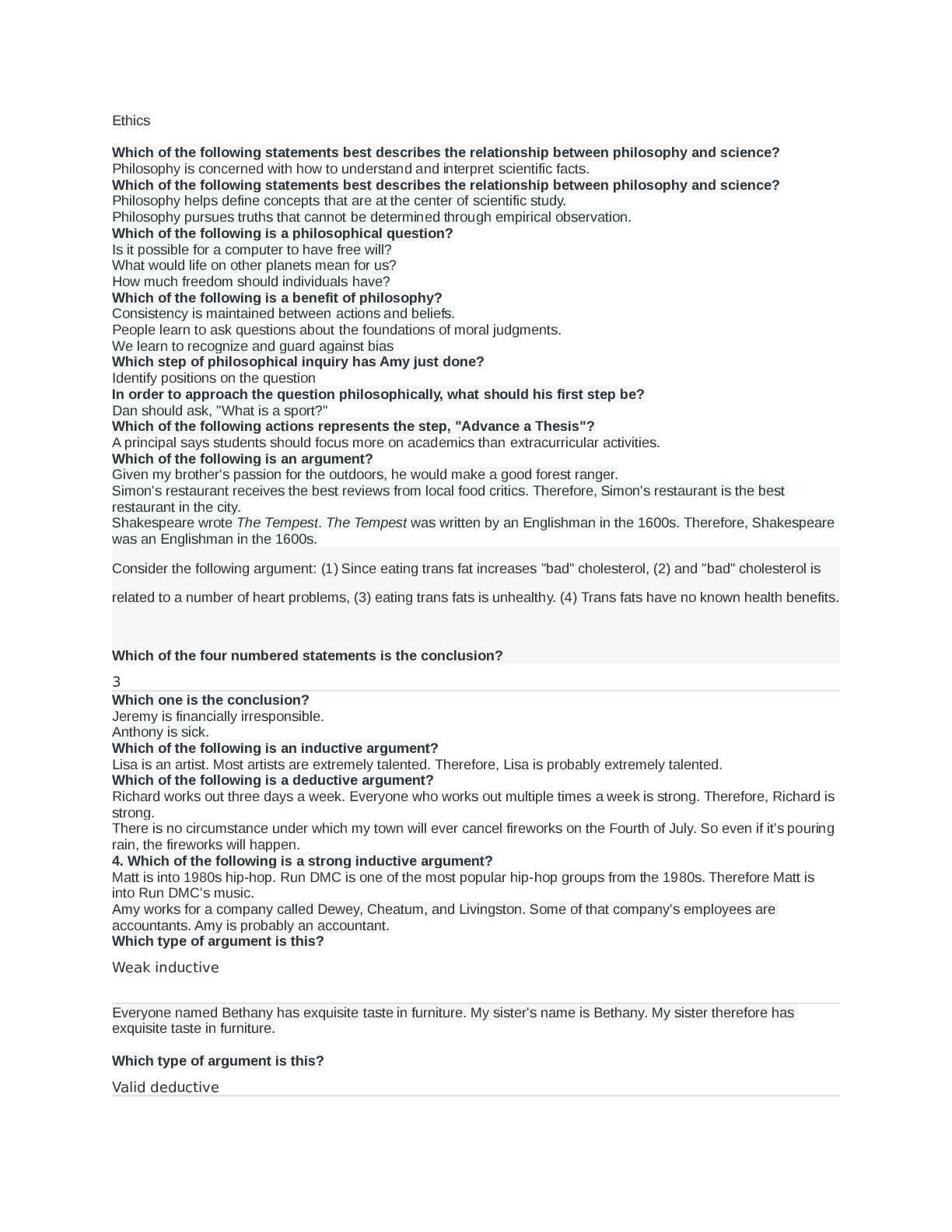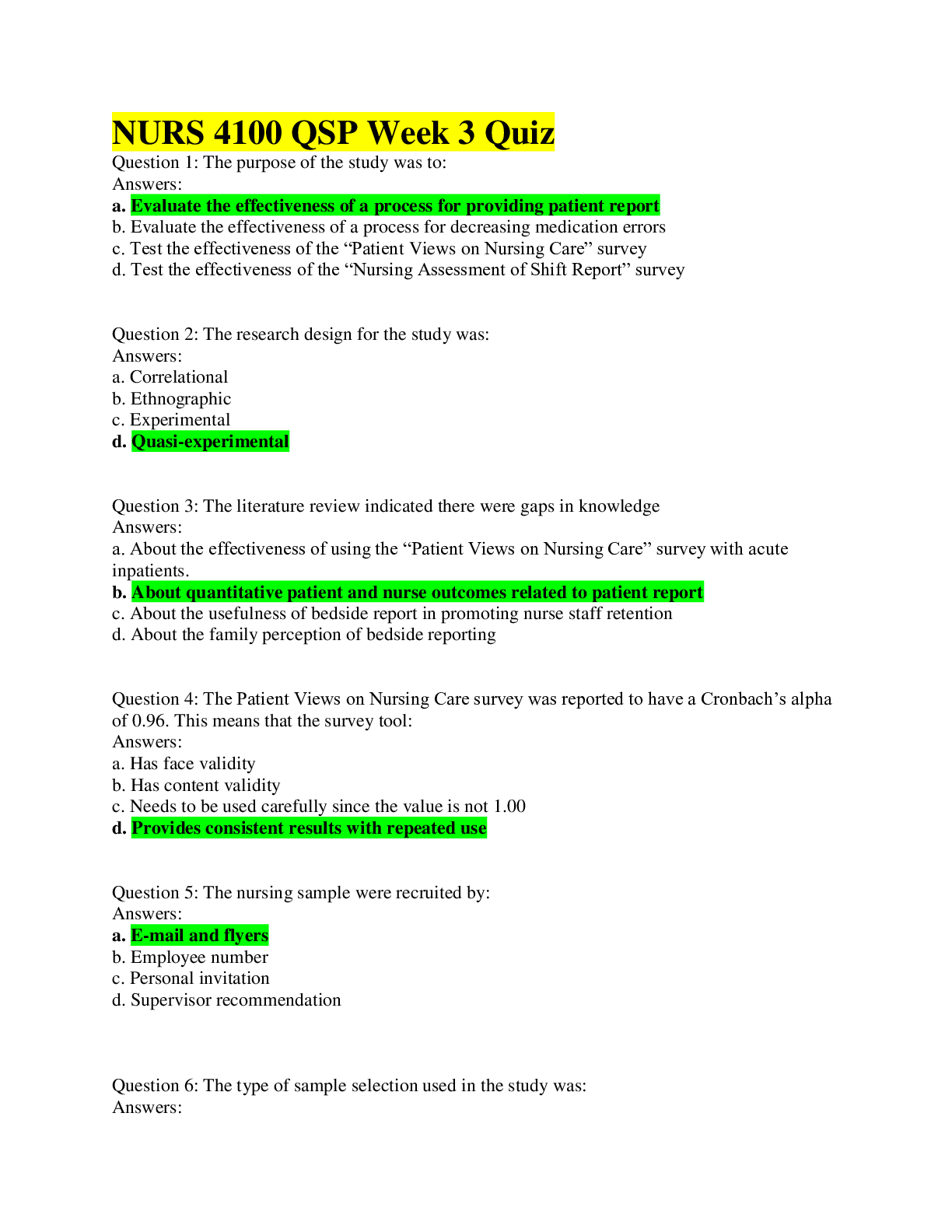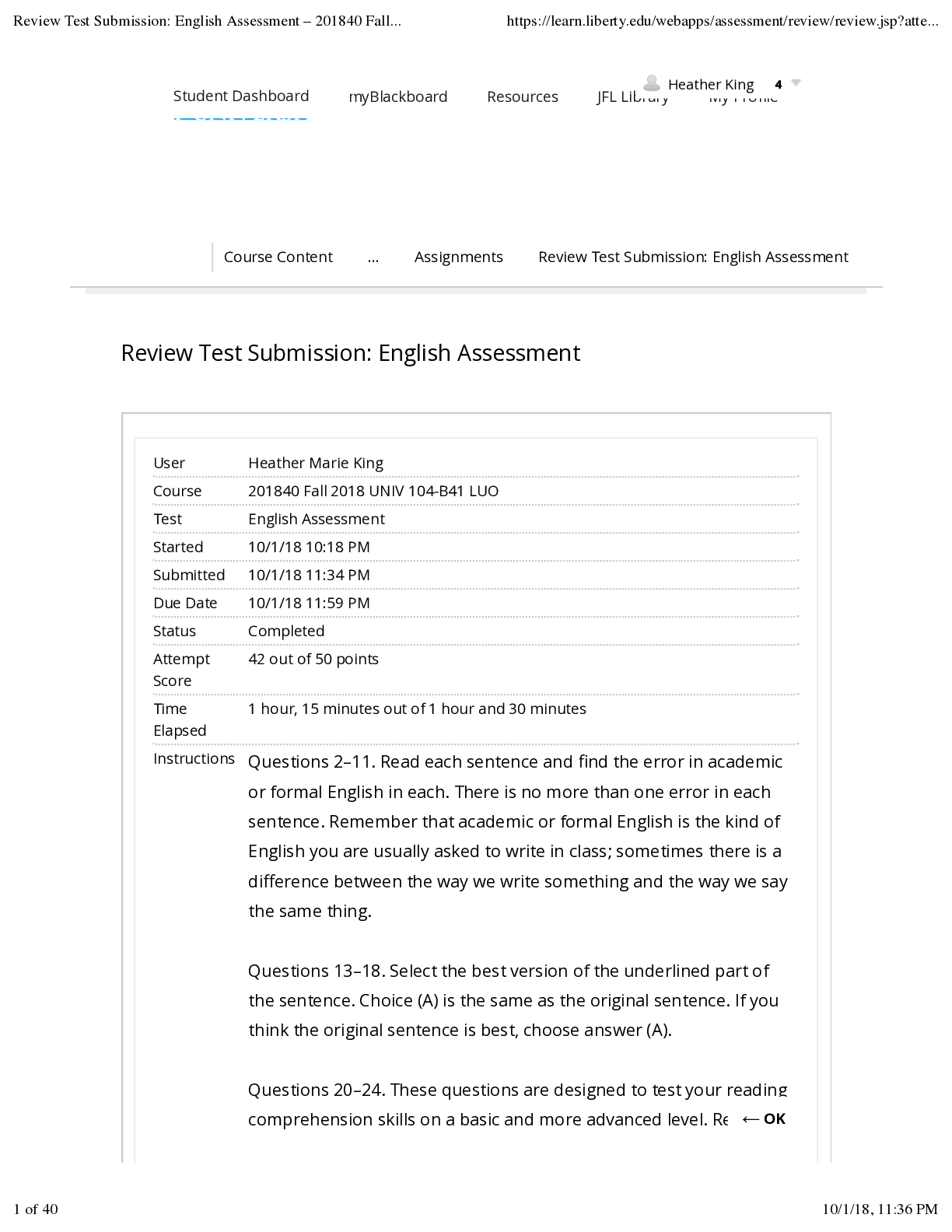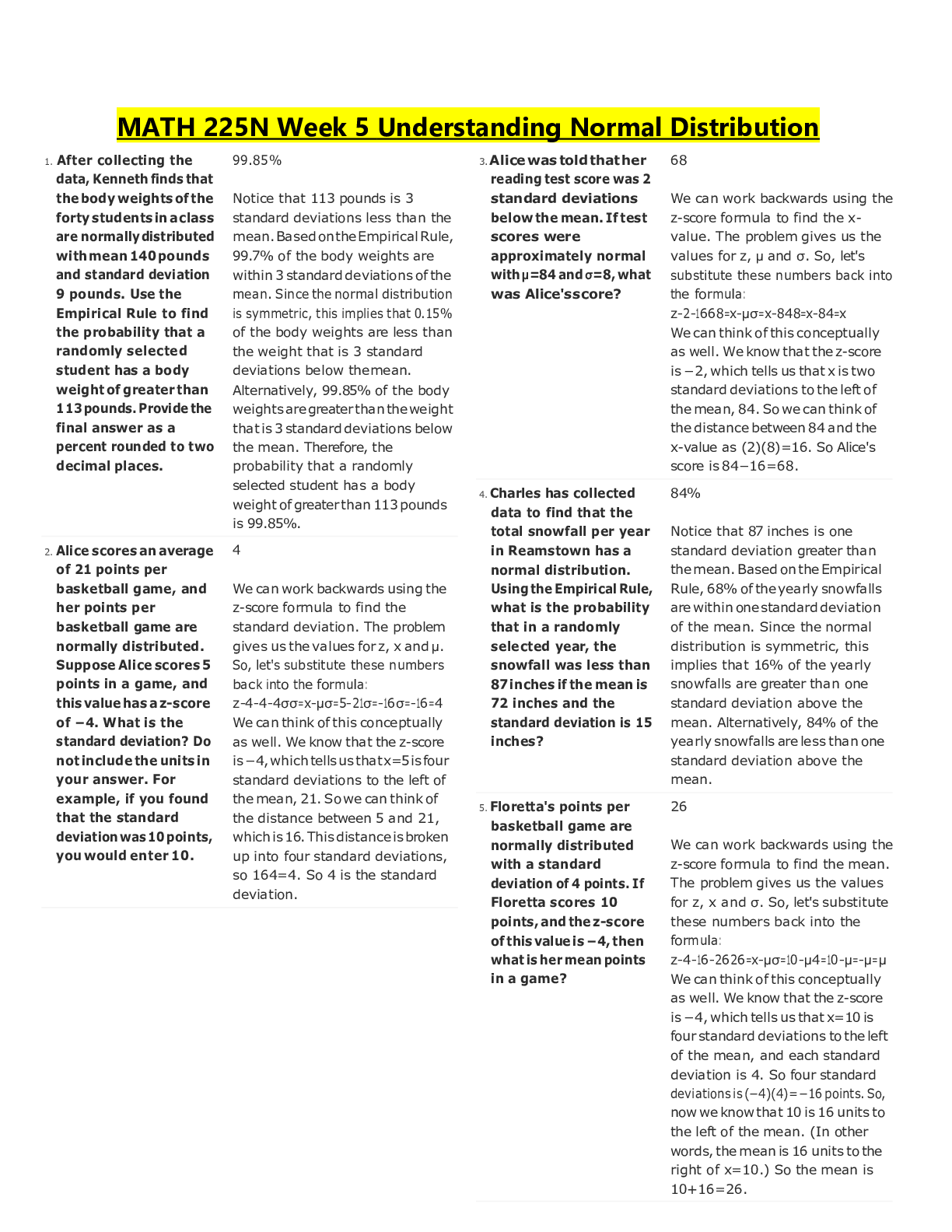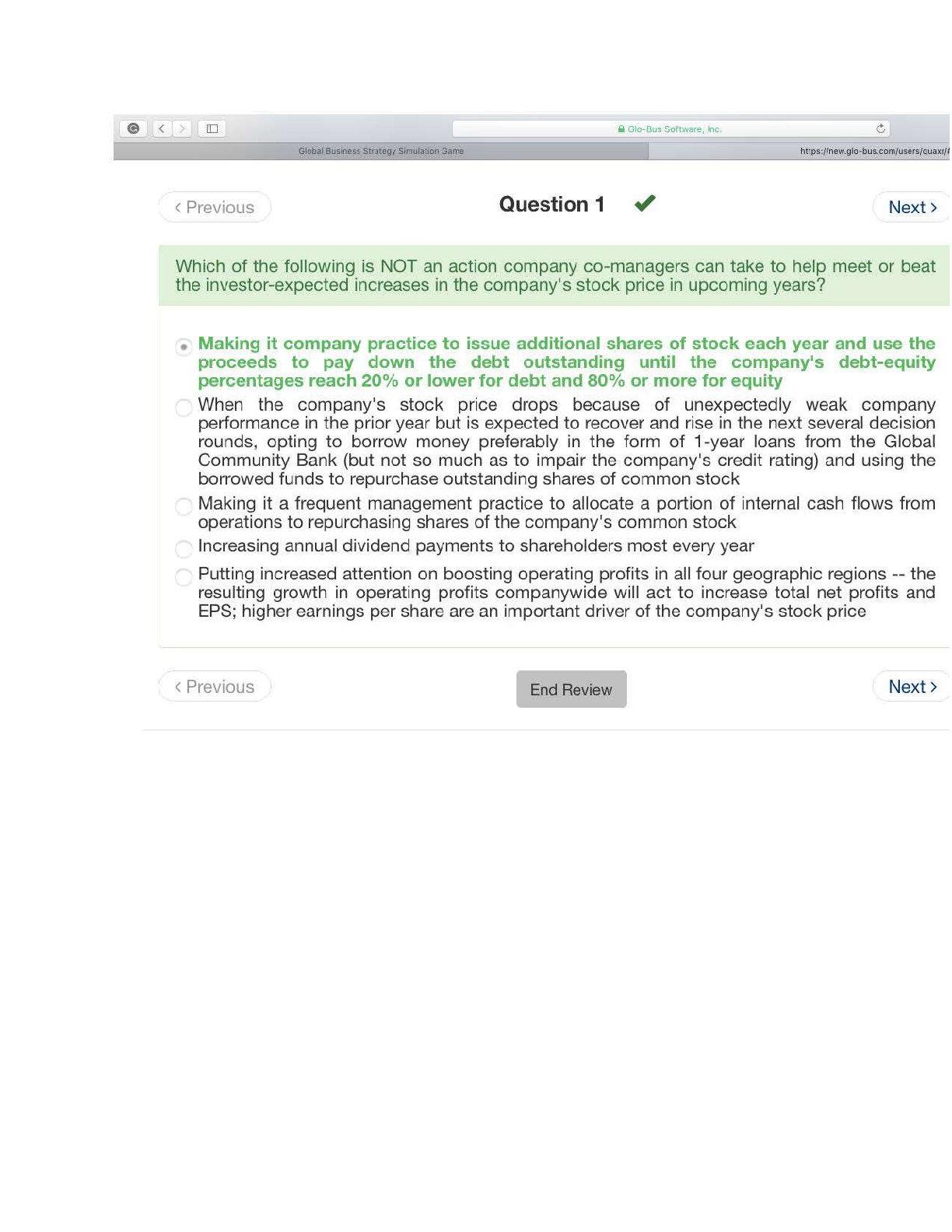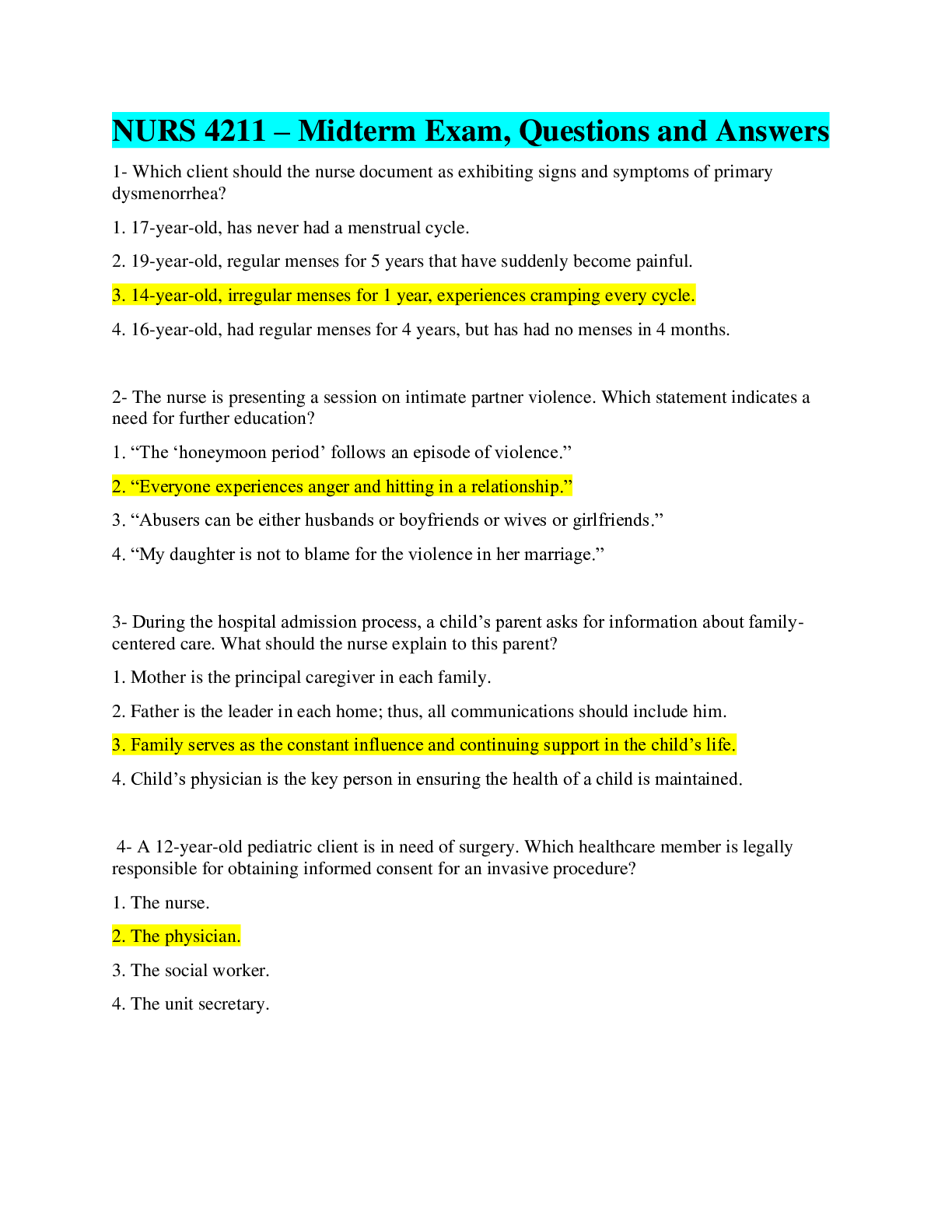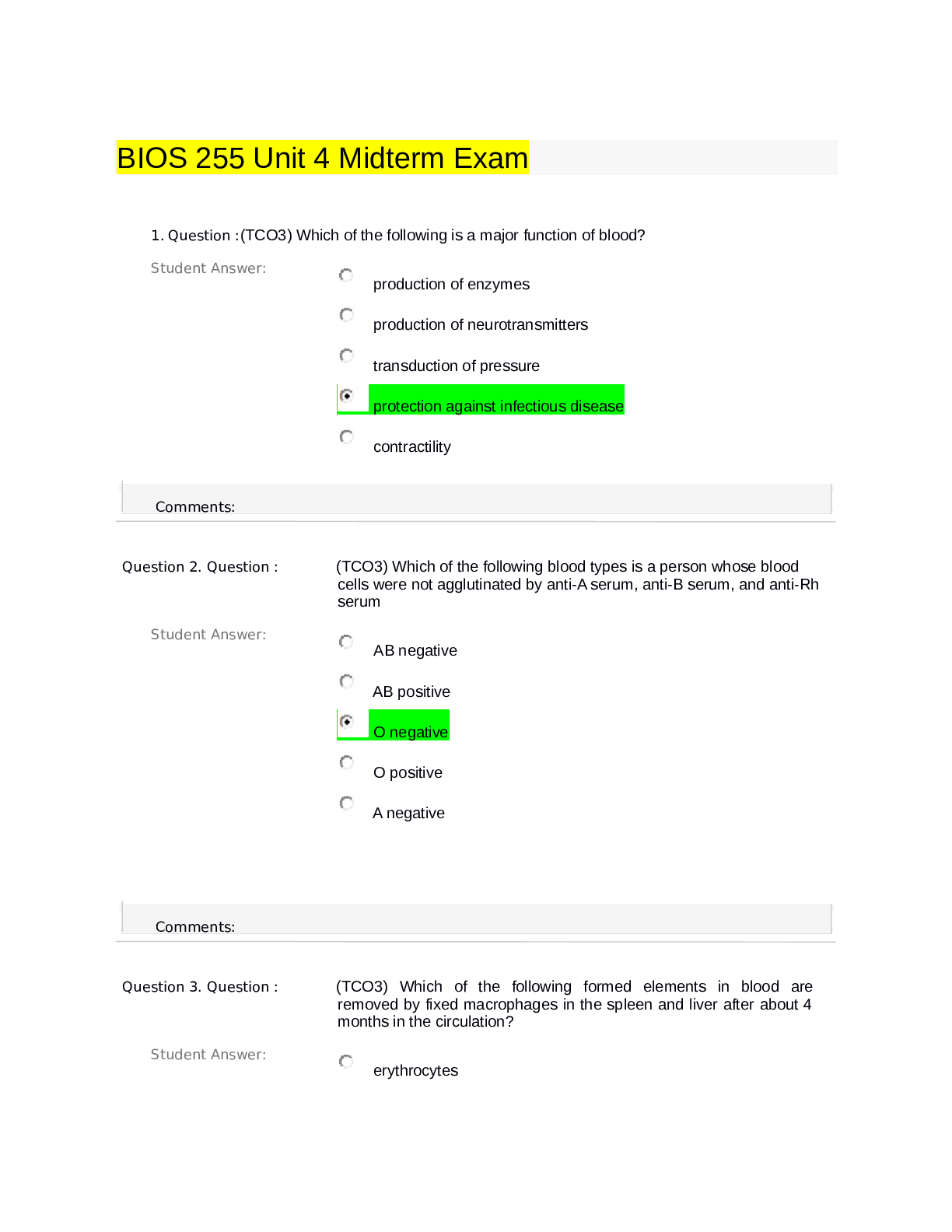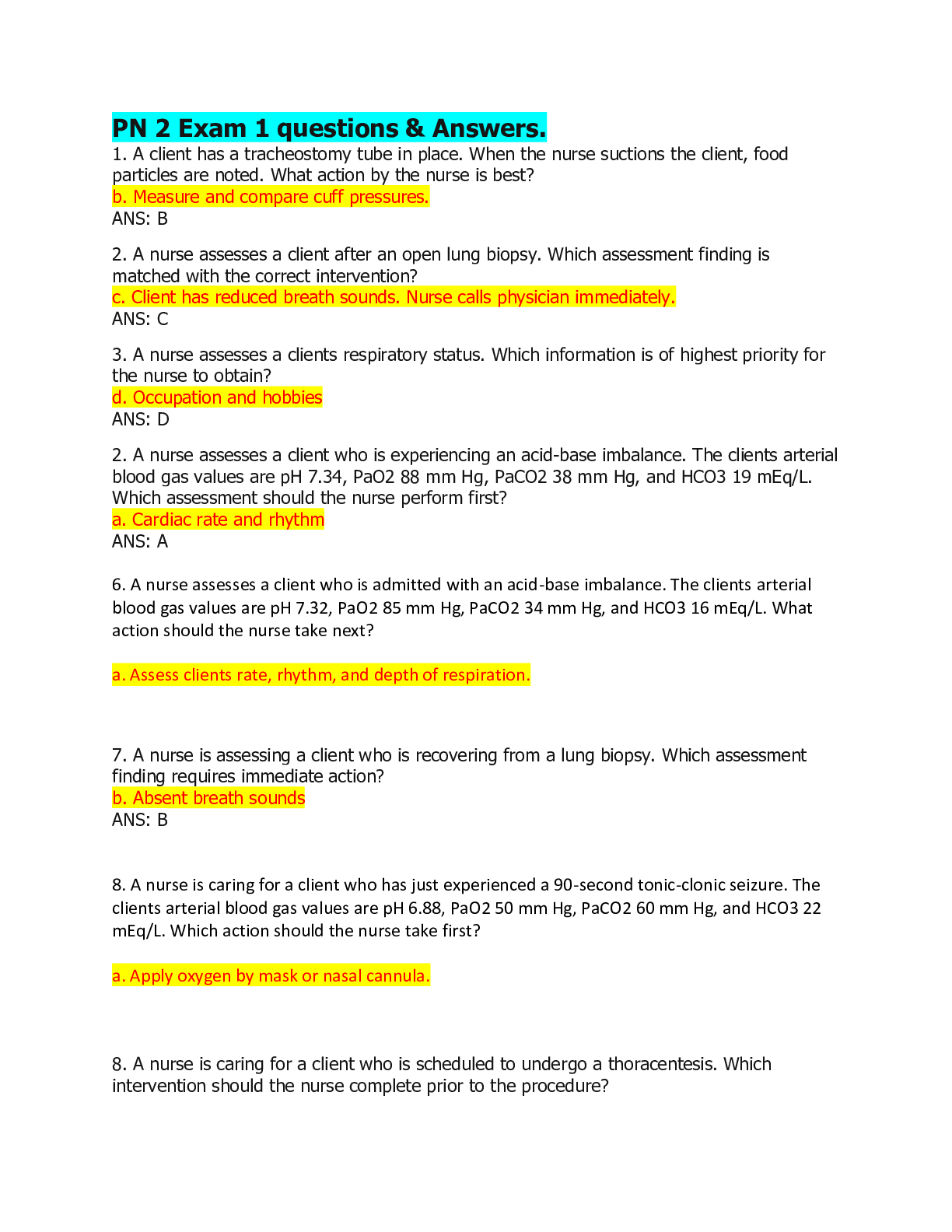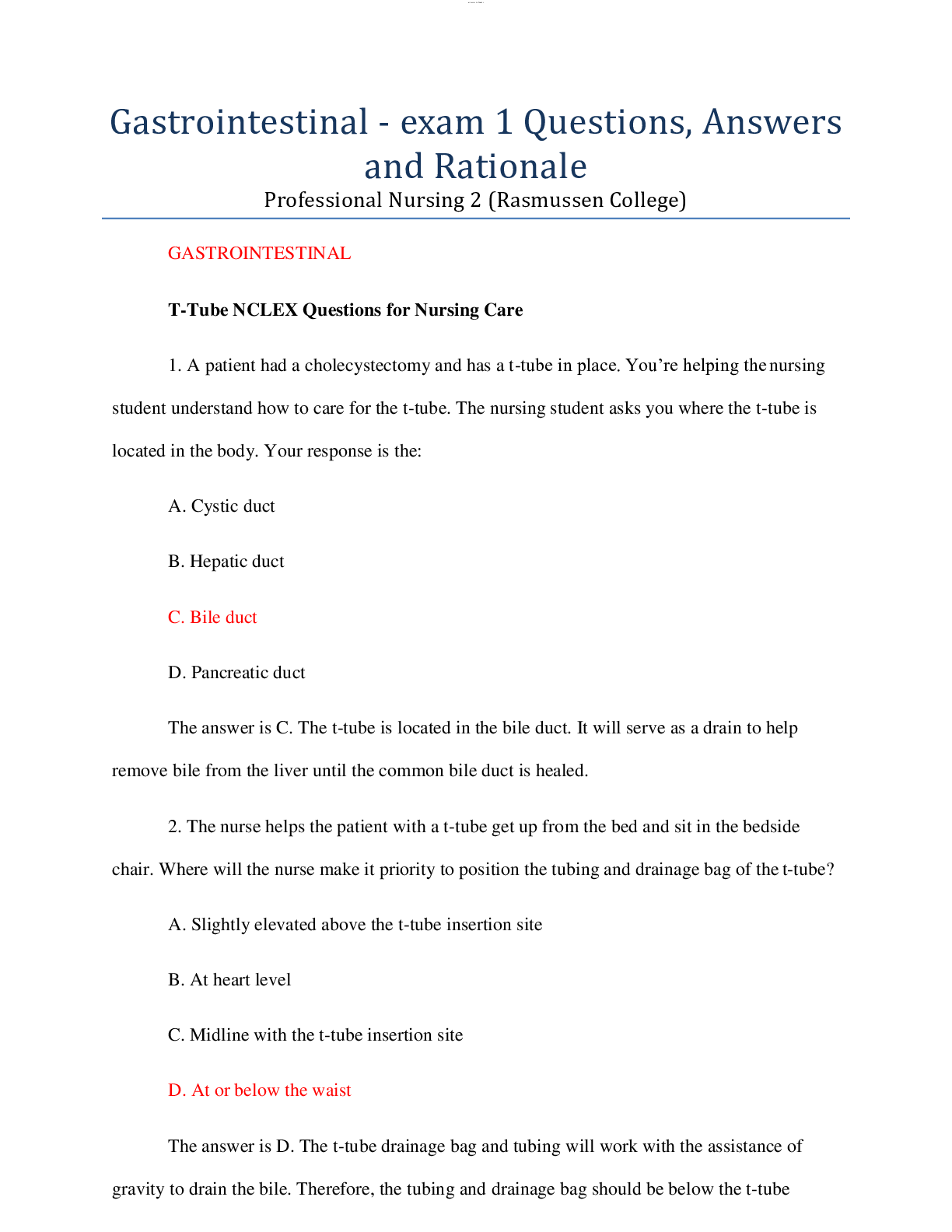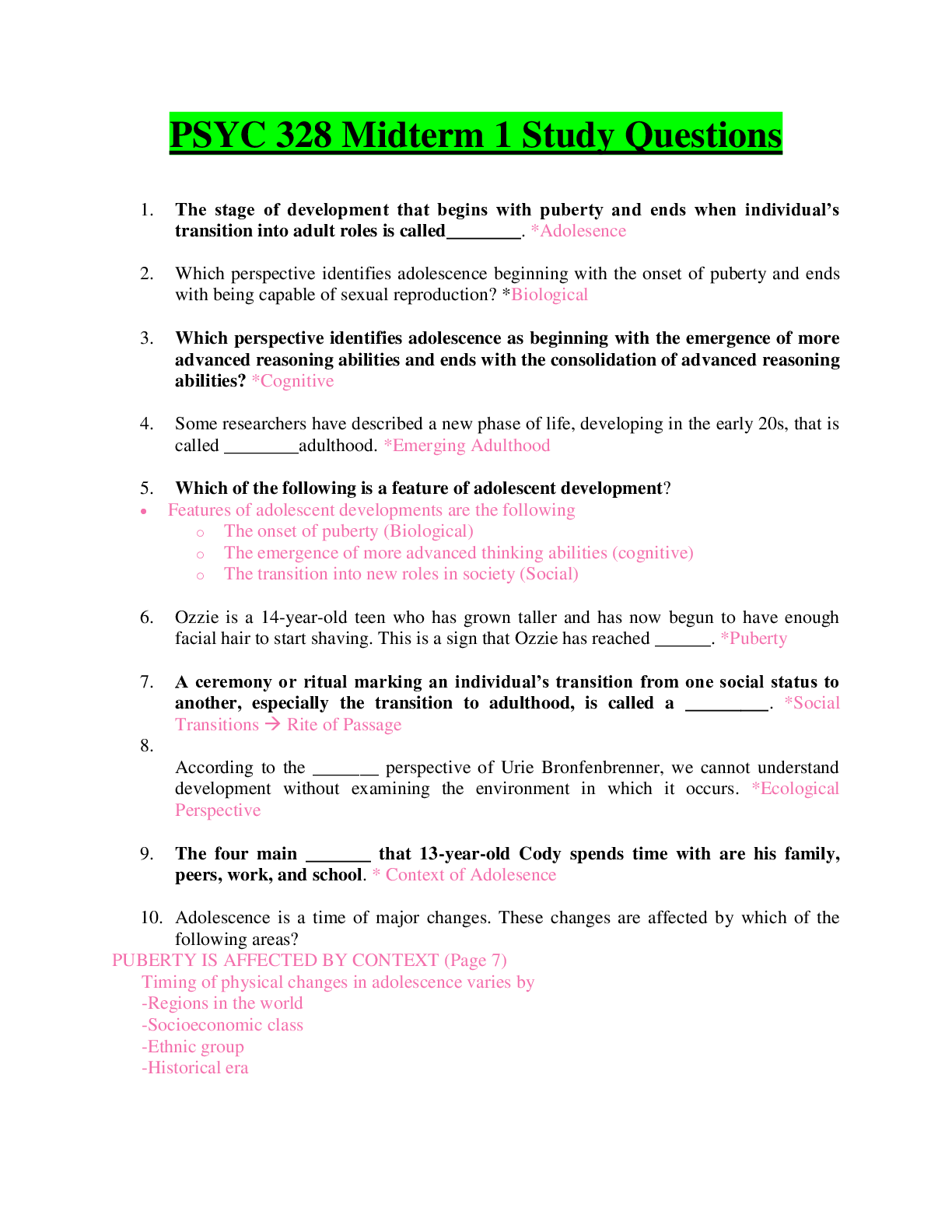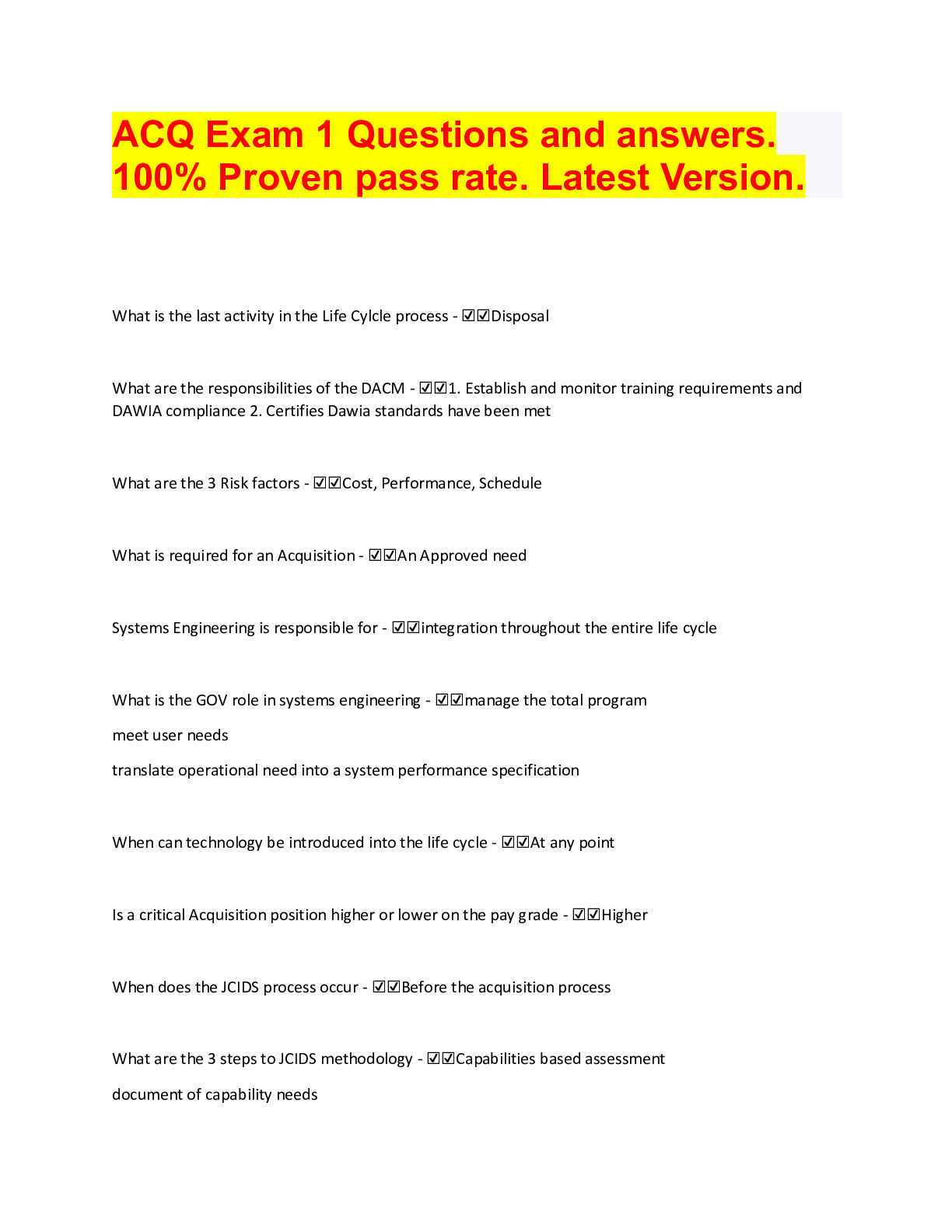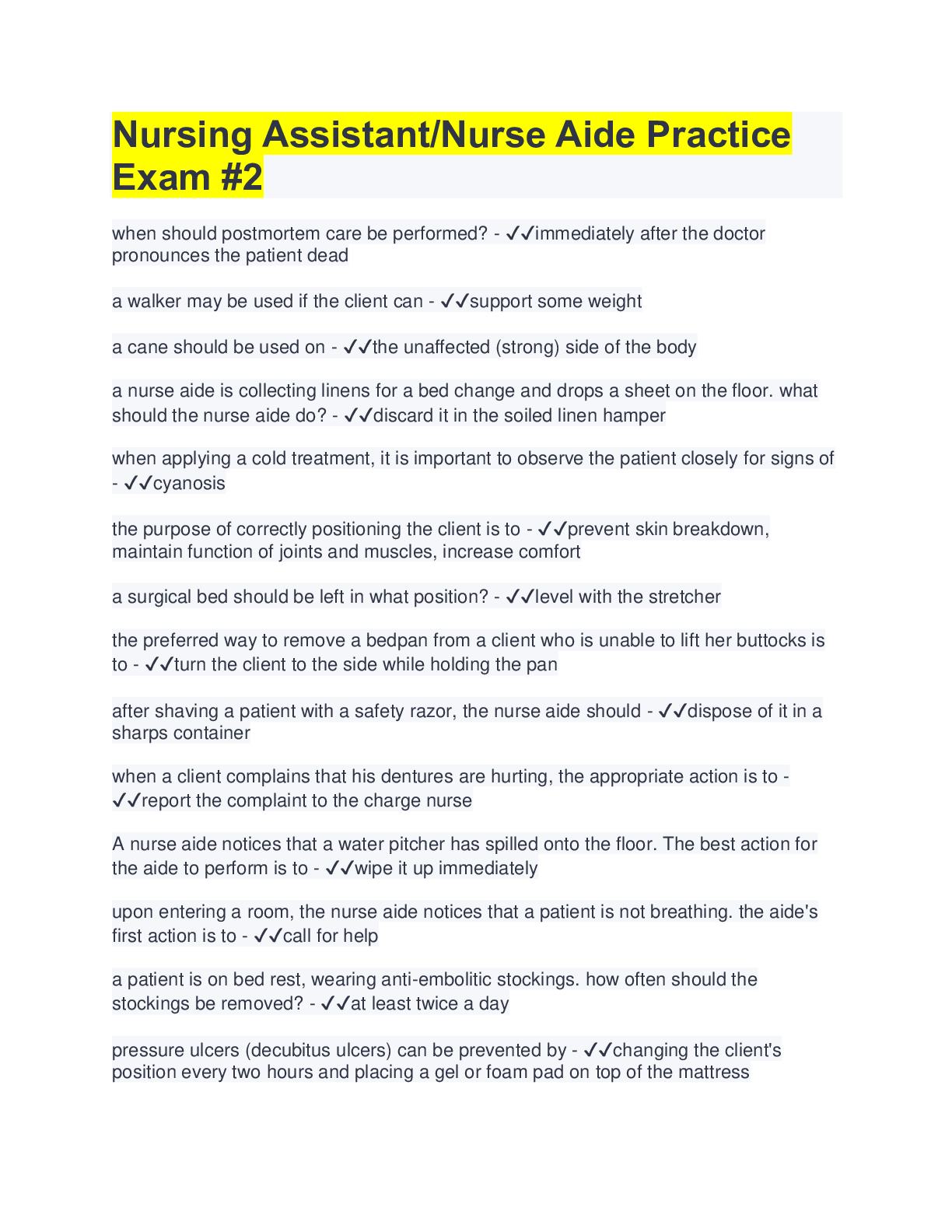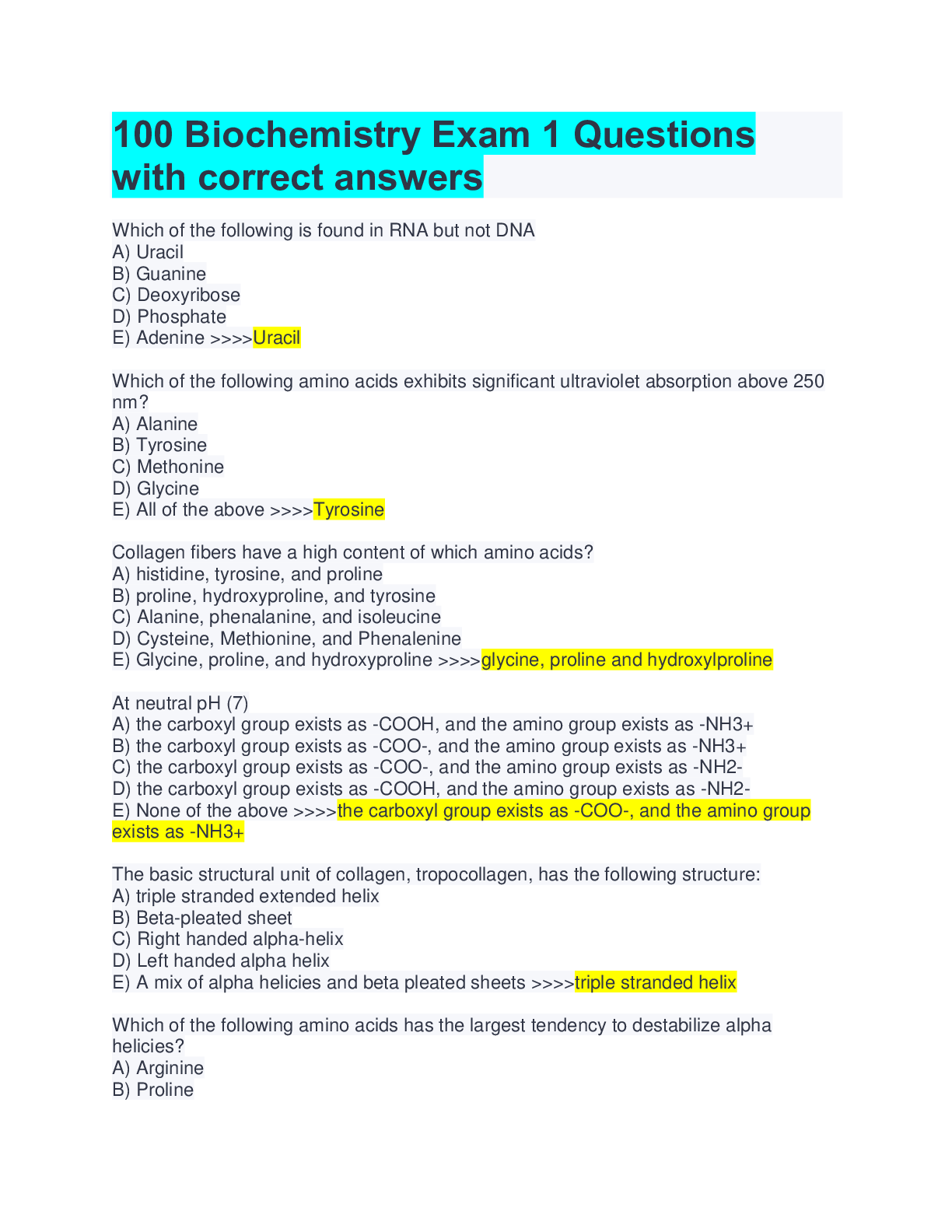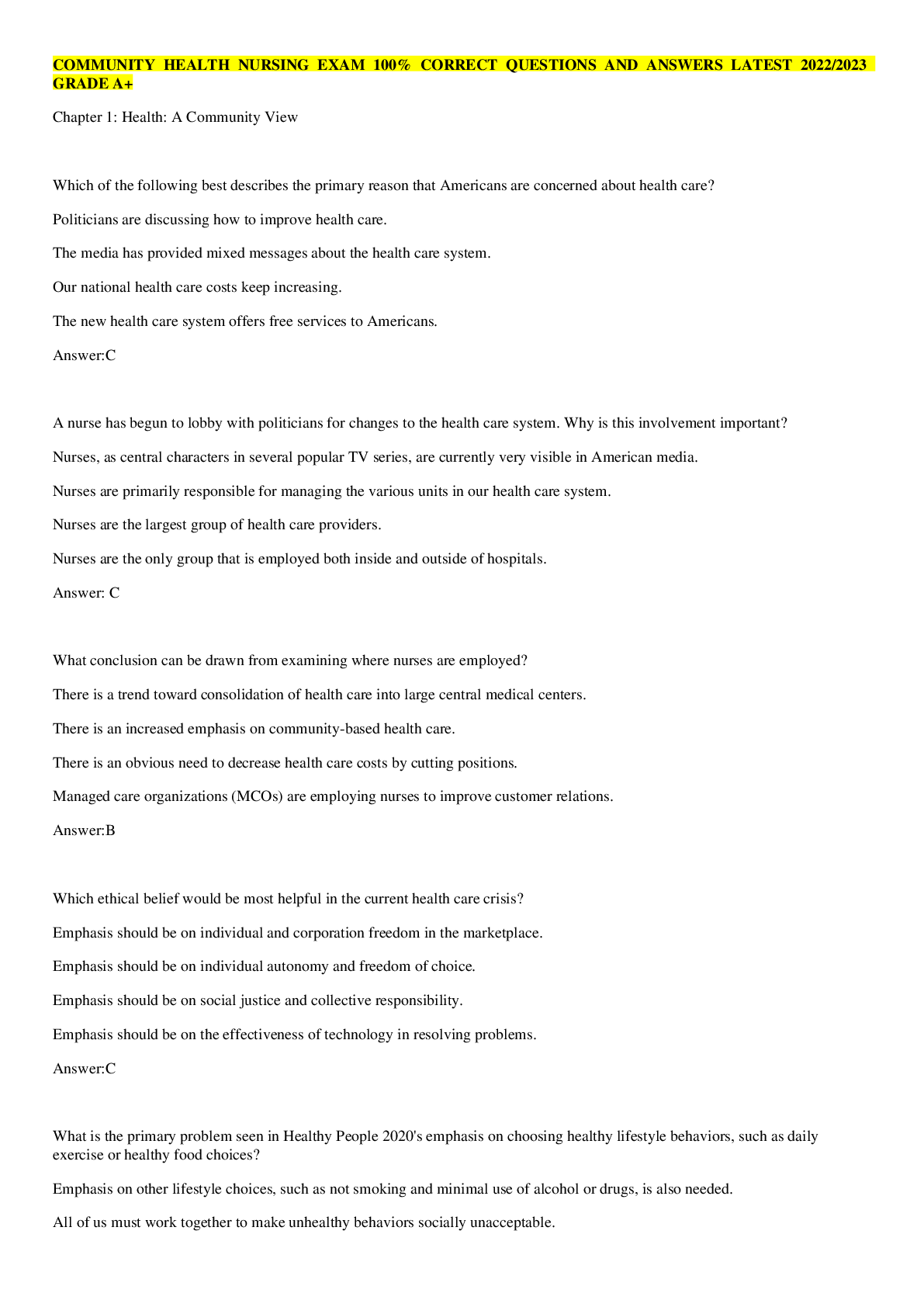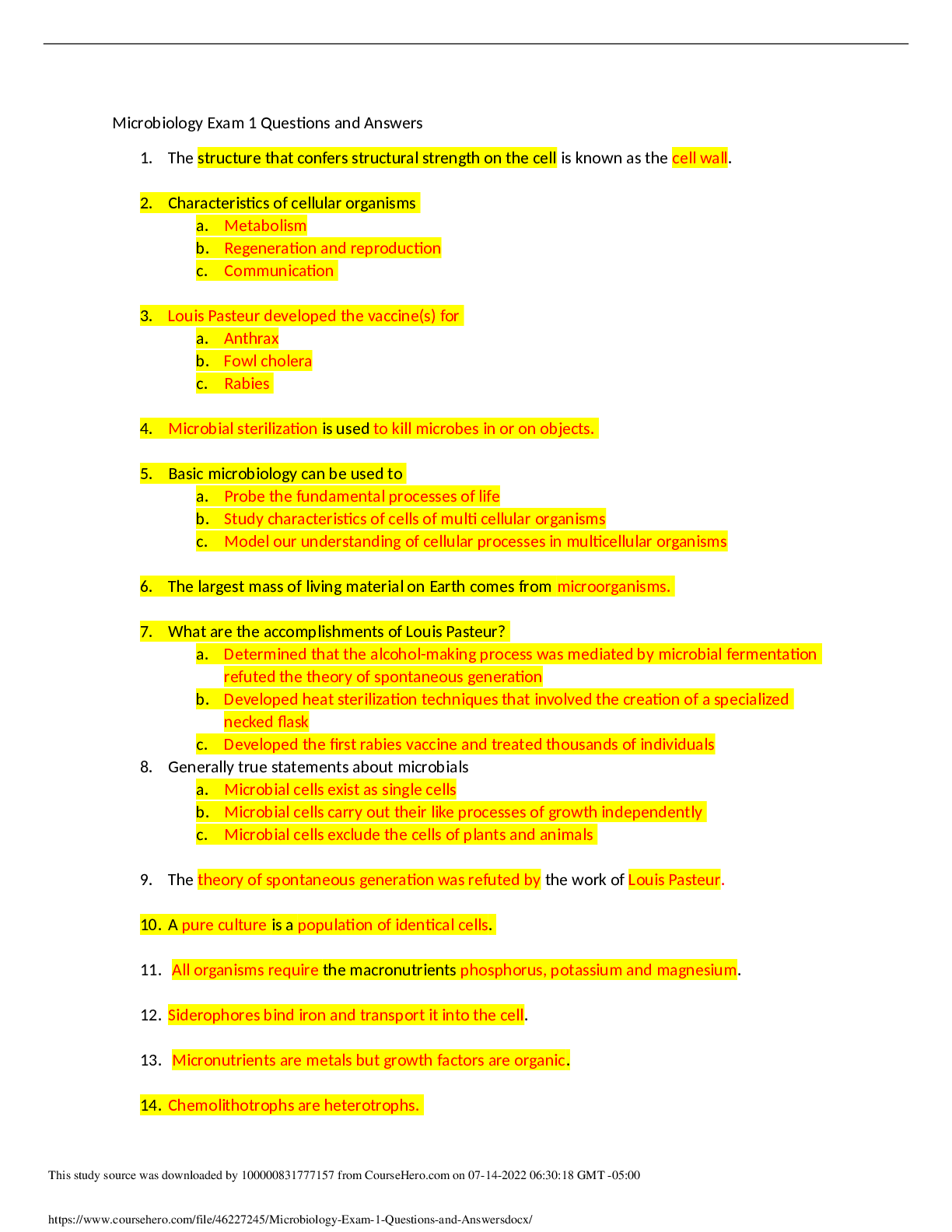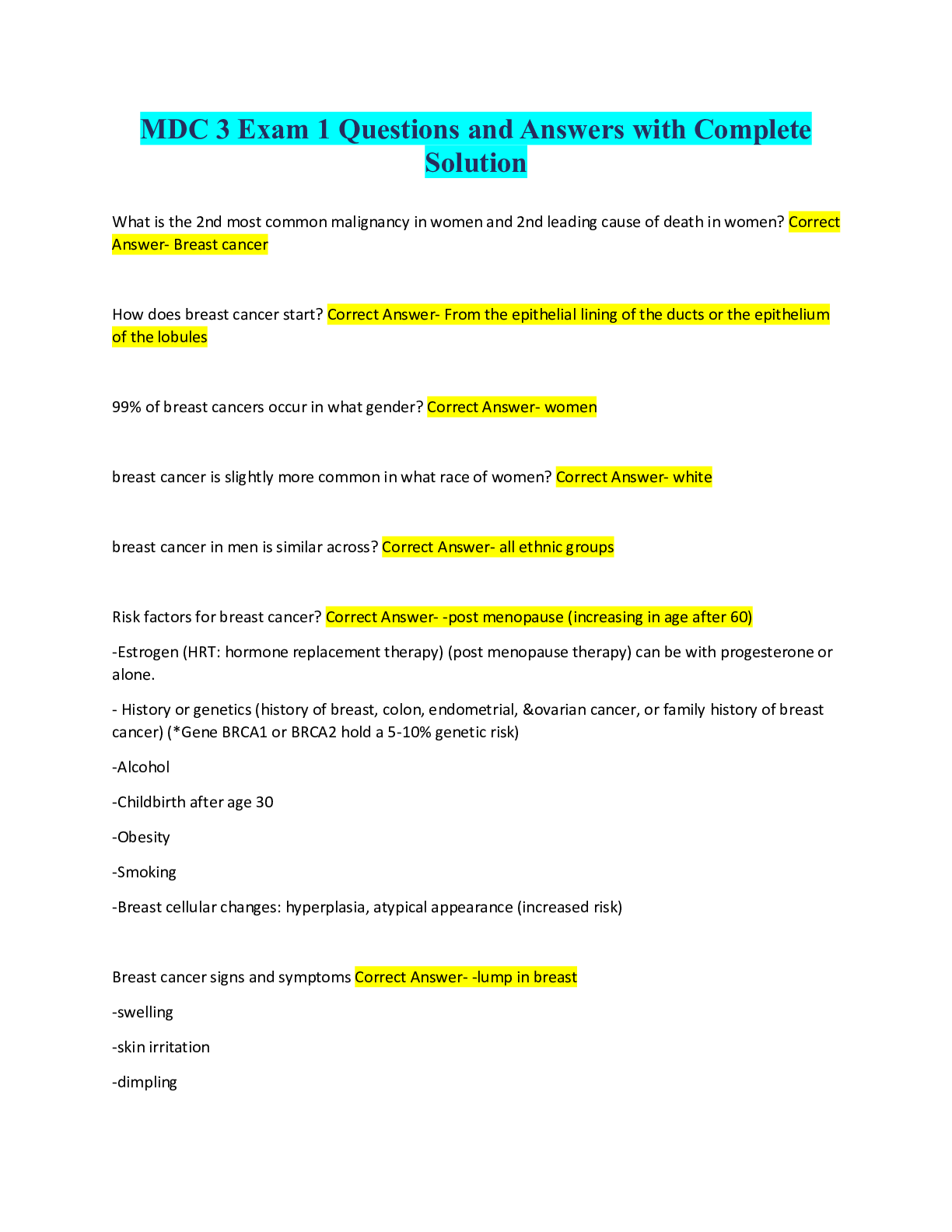*NURSING > QUESTIONS & ANSWERS > NUR 335 EXAM 1 Questions & Answers (2020) Already graded A. (All)
NUR 335 EXAM 1 Questions & Answers (2020) Already graded A.
Document Content and Description Below
NUR 335 EXAM 1 Questions & Answers Chapter 9 9.1 Liz Calhorn, 18 years of age, asks how much longer her nurse practitioner will refer to the baby inside her as an embryo. To ensure team members us... e terms consistently, the nurse would want them to know the conceptus is classified as an embryo at what time? a. At the time of fertilization b. When the placenta forms c. From implantation until 20 weeks d. From implantation until 5 to 8 weeks 9.2 Liz Calhorn tells the nurse she is worried her baby will be born with a congenital heart disease. What assessment of the umbilical cord at birth would be most important to help detect congenital heart defects? a. Assessing whether the pH of the Wharton jelly is higher than 7.2 b. Assessing whether the umbilical cord has two arteries and one vein c. Measuring the length of the cord to be certain it is longer than 3 ft d. Determining that the umbilical cord is neither green nor yellow stained 9.3 Liz Calhorn asks the nurse why her nurse midwife is concerned whether her fetus’s lungs are producing surfactant. The nurse’s best answer would be: a. “Surfactant keeps lungs from collapsing at birth, so it aids newborn breathing.” b. “Surfactant is produced by the fetal liver, so its presence reveals liver maturity.” c. “Surfactant is necessary for antibody production, so it helps prevents infection.” d. “Surfactant reveals mature kidney function, as it is important for fetal growth.” 9.4 To investigate whether there are any psychosocial predictors of women who smoke during pregnancy, a cross-sectional analysis of a birth cohort was reviewed. In this prospective study, the answers to questionnaires completed by 514 mothers shortly after the birth of their full-term infants found that 14.8% of the participants smoked. Of those women responded that they smoked during pregnancy, they were also more likely to have the following characteristics: lower education, maternal age less than 20 years, unmarried, history of elective abortion, history of unplanned pregnancy, lack of emotional acceptance of the pregnancy by the mother and father, emotional distress, and alcohol consumption (Širvinskienė, Žemaitienė, Jusienė, et al., 2016). Based on the previous study, which statement by Liz Calhorn would make the nurse most worried she might have difficulty quitting smoking during the remainder of her pregnancy? a. “I sometimes do have a few beers on the weekend with my boyfriend.” b. “When I feel tense, I like to shop. It really takes away that bad feeling.” c. “I’m trying to stop smoking so I won’t have to smoke around my baby.” d. “My mother had five children with no trouble; why am I so different?” 9.5 Liz Calhorn is scheduled to have an ultrasound examination and the nurse wants to ensure that she understands and is prepared for this procedure to mitigate her anxiety. What instruction would the nurse give her before her examination? a. “Use the restroom immediately before the procedure to reduce your bladder size.” b. “The intravenous fluid used to dilate your uterus does not hurt the fetus.” c. “You will need to drink at least three glasses of water before the procedure.” d. “You can have medicine for the pain of any contractions caused by the test.” 9.6 Liz Calhorn is scheduled to have an amniocentesis to test for fetal maturity. To help make sure the procedure is successful, what instruction would be best to give her before this procedure? a. “Void (pee) immediately before the procedure to reduce the size of your bladder.” b. “The X-ray used to reveal your fetus’s position will have no long-term fetal effects.” c. “The IV fluid used to dilate your uterus is isotonic saline so will not hurt the fetus.” d. “Your fetus will have less amniotic fluid for the rest of pregnancy, but that’s all right.” 10.1 How women feel about being pregnant has a great deal to do with how anxious they are about becoming pregnant. To investigate whether women look forward to a second birth or whether anxiety about their first birth makes them reluctant to have a second child, researchers interviewed 908 women who had given birth to at least one child, asking them to “please describe your feelings when you think about giving birth in the future.” Results showed that two thirds of women who responded had mostly positive feelings; one third of women stated they were frightened of future childbirth. The qualitative analysis resulted in an overall theme of women feeling a mixture of both dread and delight at the thought of a second pregnancy (Rilby, Jansson, Lindblom, et al., 2012). Based on the previous study, which statement by Lauren would make the nurse believe she’s having a typical reaction to her second pregnancy? a. “I’m feeling good about having a second baby, but a bit worried at the same time.” b. “I think having a second child is going to be totally wonderful. I’m sure it will be so much easier.” c. “I’m really looking forward to watching my two children play together in the future.” d. “I’d rather my husband had this one; knowing what it all involves makes it even harder.” 10.2 Lauren wasn’t totally happy about learning that she was pregnant. What psychological task is important for the woman to complete during the first trimester of her pregnancy? a. Accepting morning sickness nausea b. Accepting the fact that she is pregnant c. Appreciating the responsibility of having a baby d. Choosing a name for her baby 10.3 Lauren Maxwell is aware she’s been showing some narcissism since becoming pregnant. How would the nurse describe this phenomenon to an unlicensed care provider? a. She feels pulled in multiple directions. b. She feels a need to sleep more than usual. c. Her thoughts tend to be mainly about herself. d. She often feels emotionally “numb.” 10.4 Lauren Maxwell did a urine pregnancy test but was surprised to learn a positive result is not a sure sign of pregnancy. As the nurse is recording her result in the electronic health record, she asks what a positive sign would be. The nurse should cite what finding? a. She has noticed consistent abdominal and uterine growth. b. She can feel her fetus move more than once per hour. c. A serum tests reveals hCG. d. A fetal heartbeat can be seen during an ultrasound exam. 10.5 Lauren Maxwell’s doctor told her she had a positive Chadwick’s sign. When she asks the nurse what this means, the best answer would be which of the following? a. “Your abdomen feels soft and tender, a normal finding.” b. “Your uterus has tipped forward, a potential complication.” c. “Your cervical mucus feels sticky, just as it should feel.” d. “Your vagina looks dark in color, a typical pregnancy sign.” 10.6 Lauren Maxwell overheard her doctor say insulin is not as effective during pregnancy as usual. How would the nurse explain how decreased insulin effectiveness safeguards the health of her fetus? a. Decreased effectiveness of insulin prevents the fetus from having low blood sugar. b. Because insulin is ineffective, it cannot cross the placenta and harm the fetus. c. The lessened action of insulin prevents the fetus from gaining too much weight. d. It is the mother, not the fetus, who is guarded by this decreased insulin action. 11.1 One of the first things a woman who suspects she is pregnant must do is choose a primary healthcare provider to guide her through her pregnancy. Many women ask, “What type of care provider should I choose?” To investigate whether pregnancy care and outcomes differed when women chose a nurse-midwife rather than a physician as their primary care provider, researchers examined 15 different trials involving 17,674 women researchers interviewed a sample of 6,421 Canadian women, all 15 years of age or older, all who had given, birth to a singleton baby, and all who were living with their infant. Results of the study showed women whose primary prenatal care provider was a nurse-midwife were more likely to be satisfied with their maternity care experience and information provided on pregnancy and birth topics and have improved outcomes for both the birthing parent and the infant. They were prescribed fewer ultrasounds and were more likely to attend prenatal classes. They were almost half as likely to have labor induced and 7.33 times more likely to experience a medication-free birth, experienced fewer inductions, forceps or vacuum deliveries, amniotomies, episiotomies, preterm births, and fewer overall fetal or neonatal deaths before 24 weeks gestation. Women who chose midwifery led continuity care had higher rates of unmedicated childbirth (Sandall, Soltanni, Gates, et al., 2016). Postpartally, they were more likely to initiate and maintain breastfeeding at 3 and 6 months (O’Brien, Chalmers, Fell, et al., 2011). Based on the previous study, if Sandra asks the nurse if she should choose a nurse- midwife as her primary care provider, how would the nurse best answer her question? a. “Of course. Nurses are always more ‘patient friendly’ than physicians.” b. “Who you choose is such a personal choice; I shouldn’t give you any advice.” c. “Nurse-midwives tend to use less medication with birth. Is that important to you?” d. Nurse-midwives don’t talk to women as much as doctors. Would you like that?” 11.2 Sandra Czerinski feels healthy, so she asks the nurse why she needs to bother coming for prenatal care. What benefit should the nurse cite when responding to Sandra’s statement? a. Discovering any allergies can reduce the risk of preterm labor. b. It allows for the collection of accurate epidemiologic and demographic data. c. It provides time for education about pregnancy and birth. d. It provides important time to interact with a prenatal group. 11.3 The nurse is reviewing Sandra’s electronic health record. While doing so, the nurse asks Sandra to clarify and confirm her surgical history. Why is it important to ask Sandra about past surgery during a pregnancy health history? a. Previous use of general anesthetics is a risk factor for preterm labor. b. Adhesions from surgery could potentially limit uterine growth. c. Previous experience with surgery means that she will likely be comfortable in a hospital setting. d. Abdominal incisions are associated with potential uterine rupture. 11.4 Sandra reports that the palms of her hands are always itchy, and the nurse notices scratches on them when you perform a physical examination. The nurse’s plan of care should specify that this problem is most likely due to what factor in women who are pregnant? a. Anxiety or fear about the pregnancy b. A potential Rh incompatibility c. Peripheral edema related to changes in fluid and electrolyte levels d. A common reaction to increasing estrogen levels 11.5 Sandra has not had a pelvic examination since she was in high school. Consequently, the nurse-midwife has asked the nurse to help make her more at ease during her first prenatal pelvic examination. What action should the nurse take? a. Have her take a deep breath and hold it as long as she can during the examination. b. Tell her to bear down slightly as the speculum is inserted. c. Encourage her to moan in a low-pitched tone because this will push down the diaphragm. d. Teach her to breathe slowly and evenly while being examined. 11.6 The nurse is reviewing danger signs of pregnancy with Sandra. In the interests of safety, which of the following would the nurse tell her to report if it should occur? a. Her uterus becomes palpable over the symphysis pubis before 12 weeks. b. Blue veins appear and can be readily observed on both of her breasts. c. She gains more than 3 lb a week beginning at 20 weeks. d. She tends to lose her balance when she wears high-heeled shoes. 28.1 John is 6 years old. The nurse should teach his parents that which of his body systems should be reaching its peak point of development at this time? a. His neurologic system b. His lymphatic system… all tonsils c. His respiratory system d. His musculoskeletal system 28.2 Preventing obesity is a major healthcare goal worldwide. To determine if preschoolers are aware of what an average weight child looks like in contrast to one who is overweight, nurse researchers recruited 17 children between 4 and 5 years of age from preschool settings. Each child was weighed and measured for height so their body mass index (BMI) could be calculated and then shown images of children of various body shapes and sizes. All the children were able to correctly identify the body shape that depicted an overweight child as if they understood the concept of overweight. When asked if they liked their own body shape, however, even those who were overweight answered “yes” or apparently had difficulty applying the concept of overweight to themselves (Burgess & Broome, 2012). John shares a similar body shape with his mother and is overweight. The nurse identifies which statement by John as typical according to the study? a. “No one looks fat in my family.” b. “I like the way I look in my uniform.” c. “We look like the people in these pictures.” d. “People shouldn’t worry about what they look like.” 28.3 John, at 6 years old, is a school-age child. What should members of the nurse’s interprofessional team recognize when caring for school-age children according to Freud? a. It’s important for parents to teach children creativity during this time. b. Children develop their moral compass or spirituality during school-age years. c. Freud saw the school-age period as a largely latent or inactive period. School age is a latent stage and that it is not a stage of great advancement d. Every school-age child needs responsibilities in order to learn trust and integrity. 28.4 John, who is 6 years old, is a school-age child. According to Erikson, the nurse should identify which developmental task to integrate health promotion activities with during this period? a. How to be creative b. How to think abstractly c. How to trust others d. How to do things well health promotion activities, learn industry or to do things well 28.5 John, who is 6 years old, says his broken leg wants to get better. When choosing an accurate and empathetic response, the nurse should be aware John is using what form of cognition? a. Magical thinking… ascribing human properties to inanimate objects is indicative of magical thinking b. Deductive reasoning c. Concrete operational thinking d. Sensorial thought 28.6 John is a school-age child, but he still has difficulty learning Piaget’s concept of conservation. The nurse recognizes this implies which statement about John? a. He doesn’t understand why his mother insists he recycle plastic or metal soda cans. b. He doesn’t understand that, when crossing a two-way street, he must look both right and left. c. He feels angry because his sister’s piece of pie is long and thin where his is short and fat…nurse understand that conservation is learning that two different shapes can actually be equal in mass or volume, and John has not yet learned this concept d. He has an imaginary friend. 29.1 Bryan is 2 months old, and the nurse is collaborating with the occupational therapist in his care. When planning care, the nurse identifies that John should sit securely at what age? a. 2.5 months b. 6 months c. 8 months d. 12 months 29.2 Beginning verbal communication is one of the most important tasks that infants need to achieve. The nurse teaches Bryan’s mother that by 12 months of age he should display which characteristics? a. “Children this age can usually say around two words, plus ‘ma-ma’ and ‘dada.’” b. “One-year-olds can usually say more words than they are able to understand.” c. “A 12-month-old child can express his or her basic needs verbally.” d. “An infant who is this age usually can’t understand spoken words.” 29.3 The nurse is discussing object permanence with Bryan’s mother. Which action by her infant best illustrates that he understands object permanence? a. The child looks for the mother after she walks away. b. The child cries when either hungry or lonely. c. The child prefers a large yellow ball to a small red one. d. The child smiles when the mobile on the crib jingles. 29.4 Scalding injuries occur in infants when caretakers spill hot beverages while holding them in their lap or, toward the end of the first year, the infant is able to pull a pan of hot liquid off the stove. To confirm the incidence of this type of injury, researchers studied the admission records of an urban pediatric emergency department in Ireland. Of 280 children seen for burns, 161 (57%) were scalds. Of these, 79% occurred in children under 5 years of age, 65% were caused by hot beverages, 16% were caused 1738 by hot water, and 16% by hot food. The areas of children most affected were upper limbs and upper trunks. The researchers concluded that more parent education as to the danger of scalding is needed to reduce the number of these very painful injuries in young children (Yates, McKay, & Nicholson, 2011). Based on the study, the nurse is most concerned about which remark by Bryan’s mother? a. “I never drive without a cup of coffee in my cup holder.” b. “I’m going to switch to drinking tea to reduce my caffeine intake.” c. “I drank coffee during Bryan’s pregnancy; it’s why he’s so high strung.” d. “I’m a coffee addict; I always have a fresh cup in my hand.” 29.5 The nurse reviews infant safety with Bryan’s mother. It is most important to teach his mother about preventing which common injuries among infants? a. Drowning and hypersensitivities b. Poisoning and suffocation c. Auto accidents and burns d. Aspiration and falls 29.6 When planning care for an infant who has unique needs, the nurse best promotes the parents’ psychosocial well-being by which means? a. Lowering the family’s expectations around their infant’s skills b. Clearly describing the etiology of the infant’s development deficits c. Encouraging the family to have more children d. Emphasizing what the infant can do more than what he or she cannot do 30.1 The nurse provides patient education to Jason’s father who had asked if it is normal for his 2-year-old son to spread his feet wide apart when he walks. Which of his statements suggests that he received accurate teaching? a. “Jason may be all right, but toddlers with dislocated hips also walk that way.” b. “A wide-spaced gait is a common characteristic of toddlers.” c. “Most toddlers walk with feet close together to better stabilize themselves.” d. “His shoes may not have a good arch and this could be causing him to walk unsteadily.” 30.2 Toddlers learn a great deal about oral communication in the course of their development. The nurse expects Jason, a 2-year-old, to have mastered which statement? a. “Red tomatoes.” b. “Daddy come.” c. “Old MacDonald.” d. “Please, please.” 30.3 As television sets become larger and thinner, viewing becomes easier. To investigate if television sets can also be a threat to young children, researchers reviewed a Canadian trauma database over a 15-year period as to how many emergency room visits were caused by a television set falling onto a young child. They identified a total of 179 injuries (20 to 24 per year). Toddlers were the most frequently injured age group, and head and neck injuries were the most common consequences of a television pulled down onto a young child (Mills, Grushka, & Butterworth, 2012). Based on the study and the AAP recommendations on television viewing, the nurse advises Jason’s parents to take which action? a. Encourage Jason to watch television in his room where the television set is smaller. b. Teach Jason to always watch television from a distance of no less than 12 feet. c. Teach Jason to use the remote control so he can watch television safely by himself. d. Allow Jason to watch television only when a parent is free to supervise his actions. 30.4 Jason’s grandmother often visits the family. When she does, she brings a number of medications with her. The nurse teaches the family to follow which precautions about unintentional poisoning? a. Advise the grandmother to keep her medicine in her purse and stress that no one should open her purse but her. b. Show Jason his grandmother’s pills and emphasize that he is not permitted to touch them. c. Assure the grandmother that as long as her vials of medicine have childproof caps, there is no danger. d. Buy the grandmother a medicine case that locks and place it on a high shelf when she visits. 30.5 Jason’s mother would prefer to use a time-out for punishment. What should the nurse teach Jason’s mother or his daycare setting caregivers about the use of this technique? a. The child should sit still for as many minutes as his age. b. The child should sit still for as many minutes as he misbehaved. c. Time-out activities can include quiet play or reading books. d. Children are not ready for time-outs until school age. 30.6 Jason replies to every request by his mother with, “No!” His mother admits that she is exasperated and embarrassed by this, and she states that she is desperate to change this behavior. How can the nurse best meet the mother’s expressed learning needs? a. Have her tell Jason she doesn’t want him to say no anymore. b. Instruct her to answer all Jason’s questions by saying, “No!” c. Encourage her to reduce the number of questions she asks Jason. d. Tell her to explain he is not using good communication skills. 31.1 Cathy, who is 3 years old, constantly asks questions. When teaching her father about communication skills in children of this age, the nurse should state that a child of Cathy’s age typically asks how many questions in a day? a. Around 50 b. 100 to 200 c. 300 to 400 d. 600 or more 31.2 Many preschoolers have difficulty falling asleep or wake during the night with nightmares. To see if changes in the type of television watched could improve preschooler’s sleep, researchers encouraged half of a group of families studied to replace television watching with quality educational and prosocial video content through use of an initial home visit and follow-up telephone calls over 6 months. Among the 565 children studied, the most common sleep problem was delayed sleep onset (38%). Results at the end of 18 months showed that children in the intervention group had significantly lower odds of any sleep problems (Garrison & Christakis, 2012). Based on the study, what is the best advice the nurse could give the Edwards family? a. Don’t allow Cathy to watch television until she is 5 years of age. b. Encourage Cathy to watch specific DVDs that her parents choose for her. c. Discuss with Cathy that TV does not necessarily reflect reality. d. Allow her to only watch cartoons so she won’t be seeing violence. 31.3 Cathy keeps her entire family awake at night because she is so afraid of the dark. The nurse teaches Cathy’s parent to take which action to help overcome this fear? a. Assure Cathy the room’s window is locked so no one can kidnap her. b. Suggest Cathy temporarily sleep in the living room in front of the television set for safety. c. Buy a night-light for Cathy’s room and inspect the room to be certain it appears safe. d. Teach Cathy that her fear is not grounded in reality. 31.4 Cathy’s father, a police detective, says that he and his wife wish to take measures to prevent Cathy from being kidnapped. What action should the nurse recommend to this family? a. Limit playdates to Cathy’s own home. b. Withdraw Cathy from daycare to limit her exposure to other adults. c. Describe common kidnapping culprits the father knows. d. Be certain Cathy understands not to leave daycare with anyone but her parents. 31.5 Cathy’s family is expecting a new baby. When Cathy is visiting the birthing center, the nurse should promote which behavior as a means of fostering family bonding during this time of transition? a. Take action to help Cathy spend as much time with her mother and the infant as possible. b. Teach Cathy about the ways that her life might change after the birth of the baby. c. Remind Cathy that her parents love her very much. d. Explain to Cathy that she’s very lucky because sisters grow up to become best friends. 31.6 The nurse is drafting an educational handout for parents of preschoolers that addresses the topic of sex education. What guideline should be included in this educational material? a. Tell your child that you will explain these matters when they are old enough to start kindergarten. b. Emphasize the fact that sexual intercourse between adults must always be consensual. c. Describe some of the differences between boys and girls in clear and accurate terms. d. Distract your child from questions about sexuality for as long as possible. 32.1 According to Erikson, a sense of industry or accomplishment is the developmental task of the school-age period. When planning care, what would be the best activity to introduce to Shelly to help her achieve this? a. Encourage her to establish a new club. b. Suggest she begin a diary in which she records her secret thoughts. c. Help her with spelling so over a year’s time she becomes an expert at this. d. Locate small projects she could complete in 1 day and feel rewarded. 32.2 Shelly belonged to a series of clubs when she was 9 years old. How would the school nurse describe the typical characteristic of a 9-year-old’s club to the nursing student? a. Clubs have formal rules and regulations. b. Clubs are designed to help shy children get outside of their “comfort zone.” c. Clubs invariably exclude one or more children. d. Clubs always include both boys and girls. 33.3 Teaching safety is an important area to consider for school-age children. Which advice would be best? a. “Keep your backpack filled to capacity to avoid falling on frequent trips back to your locker.” b. “As soon as you no longer need an automobile booster seat, you’ll no longer need a seatbelt either.” c. “Gaining weight isn’t serious in the school-age years; it only becomes a real problem after age 18 years.” d. “You’re old enough to tell if you are sick or not; your mother’s opinion isn’t as important as when you were younger.” 32.4 Shelly has told the nurse she wants to try out for cheerleading when she gets to high school. This is a sport appealing to school-age children and adolescents because of its combinations of dance and gymnastics, the friendships that can develop, and the school status it almost automatically creates. To investigate what type of injuries typically occur with cheerleading, researchers reviewed all cheerleading injuries (over 4,000) presented to U.S. emergency departments during a 5-year period. The types of injuries most often seen were sprains/strains (44%), fractures (16%), and contusions (16%). The activities resulting in the most injuries were body collisions (29%), stunting (19%), tumbling (11%), and tossing (2.5%) (Currie, Fields, Patterson, et al., 2016). Based on the study, how would the nurse best advise Shelly? a. Cheerleading will be good for her because she is likely to lose weight from the exercise. b. She will need to drink an extra source of calcium every day to avoid broken bones. c. She should pursue a sport or activity that is safer. d. She should be aware that cheerleading may be beneficial to her but does carry some risks. 32.5 Shelly tells the nurse she collected “a ton of candy on Halloween. Because of how common this phenomenon is, in consultation with a dental hygienist, you would teach children that what type of candy is less likely to cause dental caries? a. Salt water taffy b. A chocolate bar c. Chewy caramels d. Hard candy 32.6 The school-age period is the time when many young people begin smoking. To design interventions that are effective and patient-centered, the nurse should begin by acknowledging which of the following? a. Most children who try smoking do not like it. b. The media have occasionally exaggerated the risks of smoking. c. Many people view smoking as being an “adult” activity. d. Children under puberty cannot become addicted to smoking. 33.1 The nurse realizes Raul is concerned about developing body odor and that he has consulted some websites that address this problem. The nurse recognizes a valid and reliable website would cite which aspect is true of body odor in adolescents? a. It is largely dependent on ethnicity and body type. b. It is caused by an increase in the activity of apocrine glands. c. Poor hygiene is the main cause of adolescent body odor. d. Body odor can result from clogged sebaceous glands. 33.2 The nurse evaluates some of the anticipatory guidance that provided to Raul with the goal of fostering his sense of identity. The nurse identifies which statement as suggesting he is successfully working toward this goal? Select all that apply. a. “I’m debating whether I’d like to be a pilot or a race car driver.” b. “I ask my parents at least once a week to let me do more things.” c. “I handle money at my part-time job and it’s sometimes tempting to take some of it.” d. “I’m getting used to being so much taller than my younger sister.” 33.3 Raul is prescribed both a topical cream and oral tetracycline to treat his acne. The nurse identifies that he needs additional health information from which statements (list all that apply)? a. “I know acne is not contagious even though all my friends seem to have it.” b. “My girlfriend wants to borrow my tetracycline; I don’t mind sharing it.” c. “I know not to take hot showers as hot water can create new lesions.” d. “I know not to eat chocolate because that always makes lesions worse.” 33.4 Raul is depressed because his girlfriend broke up with him. Which of his statements could be interpreted as stalking? a. “I keep her photo on my bedside stand so I can kiss her goodnight.” b. “We take the same route to school every day so I often still see her.” c. “I e-mail her every night to tell her what a huge mistake she’s made.” d. “I took down her photo from Facebook but wish I could put it back.” 33.5 It has long been theorized there may be a “gateway” drug or one that, when used first, leads to further and more dangerous substance use disorders. To determine whether alcohol, tobacco, or marijuana was the gateway drug, researchers obtained information on the drug use of a nationally representative sample of high school seniors. Results of the study showed alcohol was the gateway drug, leading to tobacco, marijuana, and then other illicit substances (Barry, King, Sears, et al., 2016). Based on the previous study, which statement by Raul would give you the most concern? a. “Some of my friends got hammered last weekend but I decided not to stick around.” b. “Some of my friends use weed; they tell me it really helps them relax.” c. “My parents said I could celebrate my next birthday by drinking my first beer.” d. “My mother eats 33.6 At the conclusion of a long conversation, Raul admits he has experimented with cocaine. Which assessment finding would most strongly warrant a referral to addiction services? a. Raul has frown lines in his forehead. b. Raul has thin, fissured lips. c. Raul’s eyebrows appear thin. d. Raul lacks nasal hair. 34.1 Over 300 children (from birth through age 19 years) in the United States are seen in the emergency room due to ingestion of poisonous substances. Substances include common household products and medications. It is important to provide guidance and injury prevention information to parents to prevent unintentional ingestions by children (CDC, 2016c). Based on this information, which would be the most important question to ask Candy’s father? a. “Has Candy tried to drink something that you’re drinking?” b. “Do you keep all your prescription drugs securely locked?” c. “What do you keep in the cupboards below your sinks?” d. “Where do you store the alcoholic beverages in your house?” 34.2 With the participation of her father, the nurse obtains a health history from Keoto. What question should the nurse ask at the end of this and every interview? a. “Where do you think we should go from here?” b. “Is there anything else you’d like to discuss?” c. “Are you still feeling okay?” d. “Am I a good interviewer? I’m trying hard.” 34.3 Keoto’s sister is 2 years old and appears fearful of medical equipment. To preserve her comfort, the nurse can exclude blood pressure measurement from assessment until what age? a. 2.5 years b. 3 years c. 5 years d. 7 years 34.4 Pressing a tongue blade against the back of the throat causes a gag reflex. When would the nurse want the team members to know it is important not to elicit a gag reflex? a. When a child is under 5 years of age b. When a child has symptoms of epiglottitis c. When a boy has a possible inguinal hernia d. When a girl has a geographic tongue 34.5 The nurse is using a stethoscope to auscultate the sound of Keoto’s mitral heart valve closing. When determining where to listen, the nurse identifies which location as best? a. Over the anterior sternum b. The right 9th or 10th intercostal space c. The left interior rim of the left clavicle d. The fourth or fifth left intercostal space at the nipple line 34.6 Keoto’s father wants to be sure Keoto’s immunizations are up to date. The nurse determines the immunization for HPV is recommended by which age? a. At 12 to 18 months of age b. Before kindergarten entrance c. At 16 years of age d. At 11 to 12 years of age 35.1 The nurse wants to review some health educational materials with Barry, age 16 years. To maximize his learning and his comfort level, this activity should take place in which type of physical space? a. Intimate space b. Social space c. Public space d. Personal space 35.2 The nurse has heard from a colleague that Barry, 16 years old, hates school. When considering the use of informatics to respond to this statement, which principle should guide the nurse’s actions? a. Communication is most effective when it is enhanced by cutting-edge technology. b. Referral to an appropriate, evidence-based website can likely resolve this issue. c. Technology cannot usually substitute for skilled interpersonal communication. d. Communication skills are being replaced by technologic innovation in nursing. 35.3 The nurse wants Barry, age 16 years, to increase his cognitive understanding of his condition. After teaching sessions, which statement from him would best show that his cognitive knowledge has increased? a. “I feel so much better now about the care I need.” b. “I understand I have to take two types of medicine.” c. “I’ve finally learned how to swallow big capsules.” d. “I hate having to take medicine but will take it.” 35.4 The nurse wants to teach Barry more about his hypercholesterolemia, and he has expressed a preference for video resources. To ensure that such videos are safe, age appropriate, and accurate, the nurse should do which action? a. Preview any potential video resources before referring them to Barry. b. Encourage Barry to search YouTube and then report back to you. c. Emphasize the fact that written materials are usually preferable to video materials. d. Refer Barry to his local public library and have him liaise with a librarian. 35.5 Preparing children, through the use of parental preparation, for surgery can vary in effectiveness depending on the method of education. A study was conducted to determine if a preoperative DVD instructional program could have an effect on parental knowledge, participation, and anxiety and thereby reduce the distress, pain, analgesic requirements, and length of recovery in a child undergoing same day surgery. The DVD intervention was provided to 123 parent–children (ages 3 to 10 years) dyads undergoing same-day surgery, whereas the control group received standard care. Parents in the intervention group demonstrated an increase in knowledge, provided more positive reinforcement, and increased their use of distraction and relaxation methods toward their child as compared with the control group. The children’s postoperative pain was significantly lower in the intervention group as compared with the intervention group (Chartrand, Tourigny, & MacCormick, 2017). Based on the previous study, what does the nurse determine for Wolf, 3 years old, if he seemed exceptionally anxious before surgery? a. Face-to-face instruction is preferable because it is most effective. b. He has no reason to feel anxious because 1-day surgery is finished so quickly. c. He should be given the choice between a Web-based/DVD program or face to-face instruction. d. He, like most preschoolers, is too young to understand an explanation of his surgery. 35.6 The nurse wants Wolf, 3 years of age, to know how to do the hand exercises he will need to do after surgery. When collaborating with the physiotherapist, which technique below would probably be most effective with Wolf? a. A pamphlet you read together b. A lecture from a sports hero c. Playing a game of Simon Says d. A group discussion on hand pain 36.1 The nurse collaborates with an interprofessional team to care for Becky, age 7 years. The social worker believes that Becky is showing the first signs of separation anxiety. The nurse determines which symptoms of anxiety corroborate the social worker’s assessment? a. Loud, demanding crying b. Silent, sullen protesting c. Quiet, introspective thought d. Inability to respond verbally 36.2 Preparing children and their families for surgery is crucial and also challenging. Prior to elective surgery, children and their families are often invited to visit the hospital, whereby the child is allowed to learn about the procedure in age-appropriate terms and express his or her concerns through play. Studies have investigated the use of providing age-appropriate preparatory information about procedures, through board games (Fernandes, Arriaga, & Esteves, 2014), interactive puppet shows (Cuzzocrea, Gugliandolo, Larcan, et al., 2013), or web-based programs. Utilizing different platforms not only informs and prepares the child but also reduces anxiety for the child and their caregiver(s). Based on the study, what would be the best outcome to establish after teaching Becky and her family about surgical process and her anticipated course of recovery? a. Becky and her family will adhere to preoperative and postoperative instructions. b. Becky will be able to describe the reasons why a surgical intervention is necessary. c. Becky will state that she understands the basic principles of asepsis better than before the teaching. d. Becky will state that she feels less anxious about the prospect of having her foot debrided. 36.3 The nurse wants to encourage Becky to drink a lot of water to promote hydration. During the most recent rounds, Becky drank an entire 10-oz glass at once and vomited several minutes later. Considering the failed attempt to encourage oral hydration, what would be the nurse’s best next course of action? a. Teach Becky about the consequences of failing to drink sufficient water. b. Set up a plan with Becky and her parents to provide small glasses of water frequently. c. Continue to offer her large glasses of water so she does not have to drink so often. d. Alert her that if she does not increase her fluid intake she will likely have to receive IV fluids. 36.4 Becky’s mother is worried Becky will have a traumatic hospital experience. Which of the following would the nurse advise her to do to help make Becky’s hospitalization less traumatic? a. Suggest she keep her visits short so Becky can spend time with her nurse. b. After visiting, don’t tell Becky she is leaving. Just try to slip quietly away. c. Insist Becky have blood drawn by her bed because she fears the treatment room. d. Take Becky to the playroom, a place where she can feel free from being hurt. 36.5 The nurse is worried Becky’s 2-year-old roommate might aspirate a toy the family friend brought in for her. Which of the following items is most likely to be aspirated and therefore poses the greatest risk to safety? a. Puzzle pieces b. Clothing for a baby doll c. Crayons d. Blocks that are 1-in. square 36.6 Becky’s mother and father ask the nurse what type of therapeutic play would be best for Becky. Which type of therapeutic play would best meet Becky’s needs if she will have a large bandage on her foot after surgery? a. Letting her hold and handle a syringe (with no needle attached) b. Giving her a doll and a bandage to change c. Supplying a video tape of a child having surgery for her to watch d. Giving her a book to read about a child’s hospitalization experience 38.1 After Terry receives an antibiotic, her body must distribute it to the site where it will act. Which assessment parameter addresses her body’s ability to distribute a drug? a. Terry’s renal function b. Terry’s arterial blood gases c. Terry’s plasma protein levels d. Terry’s gallbladder function 38.2 The nurse gives acetaminophen (Tylenol) to Terry in the emergency department and she has no ID band currently in place. The nurse determines which identification method is best? a. Asking her what her name is b. Stating a need to know her name c. Asking a parent to provide two identifiers (name and date of birth) d. Asking to see her school student card 38.3 Although Terry is 8 years old, she doesn’t know how to swallow pills. If the nurse needs to delegate the administration of an oral medication to a licensed practical nurse, what instruction would the nurse provide to her colleague? a. “Draw a picture of a child swallowing medicine and talk about it.” b. “Tell the child that all medicines taste sweet so she’ll take it readily.” c. “Give the child a small ice chip to use to practice swallowing.” d. “Tip the child’s head forward to avoid the possibility of choking.” 38.4 Suppose Terry, 8 years old, needs to have ear drops administered. If the nurse consults the unit’s policies and procedures, the nurse should expect which directive? a. Have the child self-administer the drops to give the child a sense of control. b. Refrigerate the drug for at least 30 minutes so it numbs the ear canal. c. Pull the pinna of the child’s ear down to straighten the canal. d. Keep the child’s head turned to the side to help retain the drops. 38.5 To investigate whether the viewing of cartoons can reduce the perception of pain in pediatric patients, younger children who presented to a major emergency department were randomized to watch a Barney cartoon in Spanish or English, and older children were randomized to view a Tarzan cartoon in either of the same two languages during painful procedures. Younger children were assessed 5 minutes before the procedure, during the procedure, and 5 minutes after the procedure using either a Poker Chip Tool or FACES Pain Scale. Older children were assessed at the same time interval using self-reporting and a visual analog scale. Results revealed children who watched the cartoons rated their pain as significantly lower than those who did not watch the cartoons (Sahiner & Bal, 2016). Based on the previous study, if Terry were watching television as the nurse approached her to insert an IV cannula, what would be the nurse’s best action? a. Temporarily turning off the TV so she can clearly hear instructions b. Asking Terry’s mother to turn the TV set to the cartoon channel c. Putting on an age-appropriate movie for Terry to watch d. Allowing Terry to continue to watch the current channel 38.6 Terry has her IV site changed to her dominant hand. Terry becomes agitated and begins to pull at her IV site. The nurse identifies which activity as best for her while her medication infuses? a. Listening to a story b. Playing kick ball in the hallway c. Playing Simon Says with her parents d. Building a tower in the play area with another child 12.1 A member of the care team is relating some statements made by Julberry Adams. Which statement would alert the nurse and the care team that there is a need to review self-care practices during pregnancy with the patient? a. “I take either a shower or tub bath because I know both are safe.” b. “I wash my breasts with clear water, not with soap, every day.” c. “I know if my partner uses a condom it can tear fetal membranes.” d. “I’m wearing low-heeled shoes to try to avoid backache.” 12.2 The nurse is reviewing an educational pamphlet that has been frequently provided to pregnant women. What statement from the pamphlet suggests that revision is necessary? a. “You may want to jog rather than walk to get an increased amount of exercise.” b. “Be certain to rest or sleep on your side, not flat on your back.” c. “Plan to pack a lunch every day so that you won’t eat junk food.” d. “Try to walk around your desk every hour to help leg circulation.” 12.3 Almost all women experience a number of minor discomforts during pregnancy. To investigate whether these symptoms are serious enough to lead to depression, researchers scored 1,507 Australian women during their first pregnancy on a depression inventory questionnaire. The women were also asked what minor body changes they were experiencing. The most frequent body changes reported were exhaustion (86.9%), morning nausea (64.3%), back pain (45.6%), constipation (43.5%), and severe headache or migraine (29.5%). Women who reported five or more physical health problems were 3 times more likely to also report depressive symptoms (Perlen, Woolhouse, Gartland, et al., 2013). Based on the previous study, which statement by Julberry would give the nurse the most concern that she should be assessed at her next prenatal visit as to whether she could be depressed? a. “I wake up every morning with backache. Do I need a new mattress?” b. “I like the job I do, although I come home exhausted almost every day.” c. “Between the headache, the backache, and the nausea, pregnancy isn’t fun.” d. “The amount of constipation I have is a surprise; I don’t usually get that.” 12.4 Julberry Adams tells the nurse she has developed painful hemorrhoids. She admits that she is embarrassed to discuss this problem but acknowledges that it needs to be addressed. The best advice to give her would be which of the following? a. “Take a tablespoon of mineral oil with each of your meals.” b. “Omit most of the fiber from your diet. This will prevent constipation.” c. “Lie on your stomach daily to drain blood from rectal veins.” d. “Witch hazel pads feel cool against swollen hemorrhoids.” 12.5 Julberry Adams has done some online research about the ankle edema that she typically experiences by the end of each day. Which statement by her would reveal that she has read accurate information about the cause of this? a. “I know this is a beginning complication; I’ll call my doctor tonight.” b. “I understand this is from eating too much salt; I’ll restrict that more.” c. “I’ll rest with my feet up to take pressure off my leg veins.” d. “I know this is from gaining too much weight; I’ll start to diet tomorrow.” 12.6 Julberry Adams makes the following statements. Which one would the nurse rate as the safest practice? a. “My brother takes medicine for heartburn; if I think of it, I’ll borrow his.” b. “I’m going to get a measles shot; I don’t want measles while I’m pregnant.” c. “There are so many medicines for headache; I’ll ask my doctor what to take.” d. “I know all over-the-counter medicine is safe; that’s why it’s over the counter.” 13.1 Tori Alarino has a BMI of 25 and is considered to be slightly overweight. The interprofessional team should recommend what range of weight gain during her pregnancy? a. 10 to 12 lb b. 15 to 25 lb c. 30 to 35 lb d. 40 to 60 lb 13.2 The nurse helps Tori evaluate some claims on a website aimed at pregnant women. The nurse identifies which statement from the website as most accurate? a. “It’s best to take your iron pills with milk.” b. “If you prefer, you can crush your iron pills to disguise the taste.” c. “Iron pills are most effective if taken with a carbonated beverage.” d. “Orange juice is an acceptable beverage to take with your iron pills.” 13.3 Gaining too much weight in pregnancy can lead to complications in the mother such as gestational diabetes; in addition, the fetus can gain excess weight with possible long-term weight problems. To see how much weight gain women perceived they needed in pregnancy, nurse researchers surveyed 54 women who were less than 20 weeks pregnant. Results of the questionnaire showed 39% of the women were overweight or obese before pregnancy. Daily caloric intake ranged from 599 to 5,856 calories. Women in all racial/ethnic groups were taking in less than recommended amounts of protein, carbohydrates, calcium, iron, folate, and fiber. Central American Hispanic women were the group who perceived they needed to gain the most weight for a healthy pregnancy; Caribbean black women, as a group, perceived they needed to gain the least weight (Brooten, Youngblut, Golembeski, et al., 2012). This study demonstrated the average woman was taking in less nutrients than required during pregnancy. How should the nurse best advise Tori about what foods she should eat during pregnancy? a. “Protein makes you gain weight too rapidly so keep all your meat portions small.” b. “Eat as much as you like all during pregnancy; you can always diet close to term.” c. “Make sure that you work plenty of leafy green vegetables into your diet.” d. “Iron causes constipation so limit your intake of iron-rich foods any way you can.” 13.4 A health history document is modified by an interprofessional group. To obtain the most accurate nutrition history from a pregnant patient such as Tori, what should the assessment document specify? a. Ask the patient to tell how much protein she eats daily. b. Assess whether the patient feels satisfied with her nutrition. c. Ask the patient to describe what she ate in the last 24 hours. d. Prompt the patient to describe her concept of ideal nutrition. 13.5 The nurse identifies which statement by Tori as suggesting she has developed pica? a. “I eat the erasers off pencils. It helps relieve my heartburn.” b. “I can’t eat a thing before 11 o’clock every morning.” c. “I notice I’ve been hungry for lemon cookies lately.” d. “I crave oranges; can’t get enough of them every day.” 13.6 Tori describes the foods she eats daily. Which nutritional risk does the nurse identify as most likely if Tori is a vegetarian? a. Lack of iron b. Lack of vitamin C c. Lack of folic acid d. Lack of vitamin B12 24.1 Suppose Moja had an amniotomy during her labor. Immediately after this procedure, which nursing assessment would be most important for the nurse to make? a. Ask her to rate her pain level after the procedure. b. Assess maternal heart rate to detect possible bleeding. c. Assess FHR to detect possible cord prolapse. d. Document the amount of amniotic fluid that has been lost. 24.2 The nurse gives a report to an OR nurse prior to a cesarean birth and describes actions she took to reduce the size of the patient’s bladder and to keep it away from the surgical field during the procedure. Which action should the nurse describe to her colleague? a. Inserting a Foley catheter to drain the bladder and decrease its size b. Administering an oxytocic drug to cause the bladder to forcefully contract c. Restricting the woman’s fluids for at least 16 hours before surgery d. Administering the woman a diuretic to reduce bladder volume 24.3 Moja Hamma needs to have an IV infusion started prior to her cesarean procedure. Which course of action would be best? a. Introduce the cannula into the back of either hand. b. Begin the IV infusion in the hand nearest to you. c. Ask Moja which hand she would prefer you to use. d. Explain that IVs are typically started in the right hand. 24.4 The nurse notices that a colleague who was helping to prepare Moja has left the room to liaise with the OR in anticipation of the cesarean birth. The nurse also notices that the colleague left Moja’s electronic health record open and in view of her support people. Which course of action would be best? a. Immediately close the record even though all care may not yet be recorded. b. Locate the nurse and ask her to come back so she can close the record. c. Minimize the record and wait for the nurse to come back and close it. d. Report the nurse to the nurse manager for violating confidentiality. 24.5 The majority of women who have a cesarean birth are physically eligible to future births vaginally. Researchers examined what influences a woman’s choice in birth mode. They looked at 20 papers reporting views of 507 women who had a previous cesarean section. Women choosing a vaginal birth after cesarean were strongly influenced by a preconceived anticipation of vaginal birth. Women seeking repeat cesarean were often influenced by a prior traumatic birth experience. Women who were open to hearing suggestions had fewer preconceptions about the birth method and were able to hear a range of options (Black, Entwistle, Bhattacharya, et al., 2016). Moja tells the nurse, although she knows she will be eligible, she isn’t certain if she wants to have a vaginal birth for her next child. Based on the previous study findings, what would be the nurse’s best assurance for her? a. “It doesn’t matter. Once a cesarean, always a cesarean is the rule.” b. “Birth is such a personal experience it’s impossible to say.” c. “Let’s talk about the risks and benefits of both types of deliveries to help you make your decision.” d. “My coworker had a vaginal birth after a cesarean birth and she was satisfied with her choice.” 24.6 Moja tells the nurse she does not intend to continue breastfeeding after she returns home, stating, “My stomach’s too painful.” What action would the nurse add to the plan of care that is most apt to be helpful to Moja? a. Insist Moja speak with one of the hospital’s lactation consultants. b. Instruct her to take over-the-counter analgesics just before breastfeeding. c. Design a study to identify factors that affect breastfeeding success. d. Explain that her uterine pain will not last more than a few more days. [Show More]
Last updated: 1 year ago
Preview 1 out of 22 pages
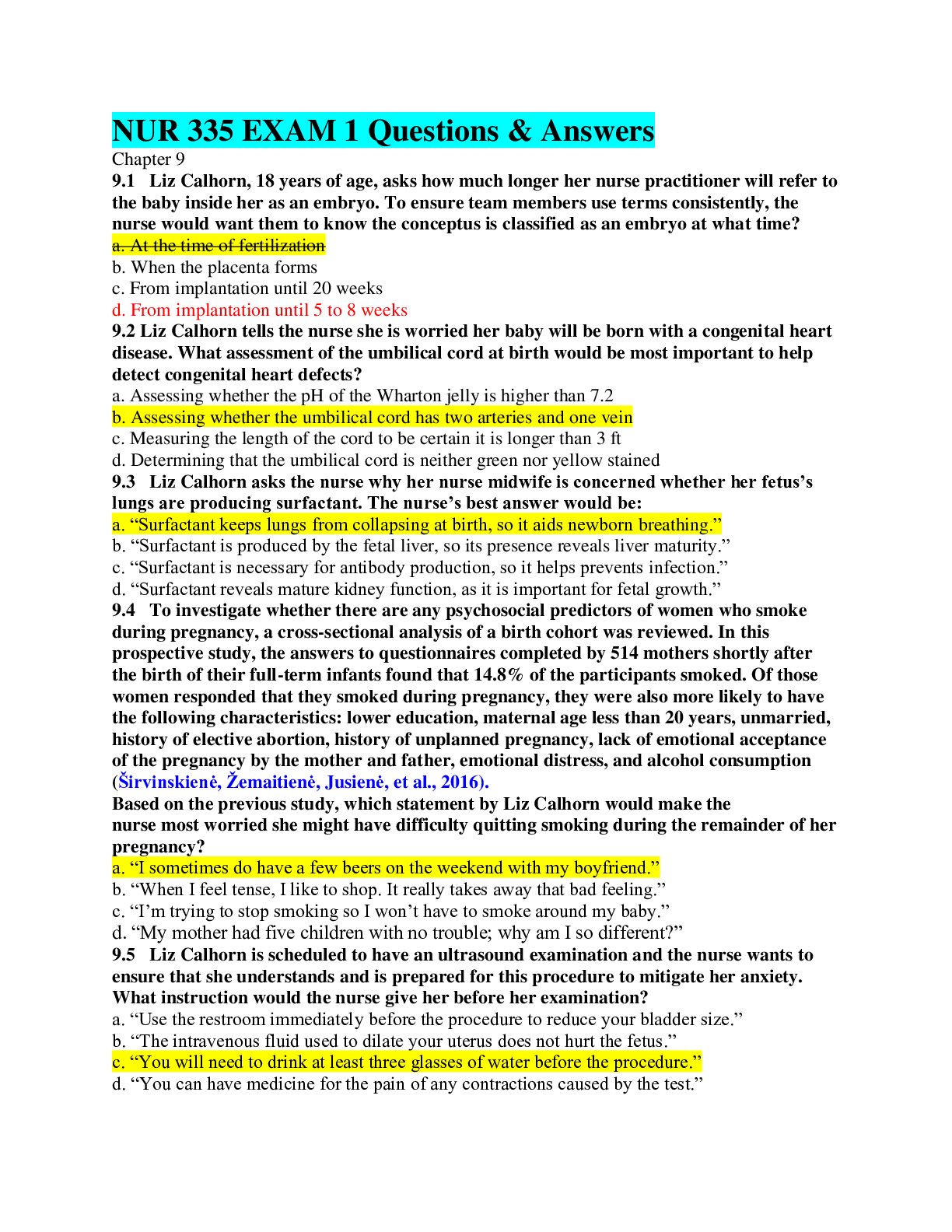
Reviews( 0 )
Document information
Connected school, study & course
About the document
Uploaded On
May 16, 2020
Number of pages
22
Written in
Additional information
This document has been written for:
Uploaded
May 16, 2020
Downloads
0
Views
154




